6 user research and UX design trends for 2023


UserTesting

The world of UX and UI moves fast. Innovation is the name of the game, and UX teams know they need to keep their fingers on the pulse.
So, what's in store for our industry in 2023 and beyond? Here's a look at the major trends, predictions and technologies revolutionizing UX and UI.
The rise of the AI researcher
The momentous launch of Chat GPT-3—which surpassed a million users in less than a week—has got us thinking about AI.
ChatGPT from OpenAI is a dialogue-based artificial intelligence that delivers eerily human-like responses to questions. While it's not always accurate, the service is proven to produce usable webpages, software code, and even poetry in just seconds.
But what's that got to do with UX? In the months and years to come, AI has the potential to revolutionize the UX function, empowering teams to deliver research and product iterations in new and exciting ways. That's why we're constantly evaluating how it might fit into how we approach user research.
We don't see a future where AI replaces researchers and designers. UX is one of the most human-centric, empathy-focused disciplines out there. In the coming years, we expect that AI will enhance our capabilities to architect top-notch user experiences.
The world of voice assistants
Google and Amazon have reportedly scaled back their voice assistant teams , resulting in layoffs and talk of “missed opportunities.” Even so, voice assistant usage is set to surge by 320% in 2023. UX teams must move beyond screen-based research to include gesture-based tests for voice interfaces.
In 2023, omnichannel experiences are where it's at. These days, consumers want to seamlessly interact with brands across their tablets, laptops, mobiles, voice assistants, and wearables. In line with this, McKinsey research shows more than half of buyers engage with a company on three to five channels during the customer journey.
The dominance of omnichannel means research and design processes need to evolve. To improve conversions and decrease bounce rates, UX teams must master the art of building cohesive, intuitive user experiences across digital mediums.
In practice, this means broadening research and design to consider the user's end-to-end journey rather than siloed interactions.
Meet the Metaverse
2022 was the year the Metaverse started creeping into our lives.
While still relatively in its infancy, the AR and VR platform is set to revolutionize online experiences in the years to come. So much so that, by 2026, Gartner predicts 25% of people will spend an hour or more in the Metaverse each day.
For UX and UI designers, the Metaverse is a total departure from traditional thinking, propelling us into a new dimension (literally).
You're probably wondering how to launch your UX team into the Metaverse. In truth, right now, UI and UX in the Metaverse is a case of discovery.
No one has the secret formula just yet. But many companies are exploring the best ways we can enable consumers to participate in VR research while uncovering the right methodologies for the job.
Architecting age-appropriate experiences
The recent passing of the California Children's Online Safety Bill might be the first American law of its kind, but it certainly won't be the last.
Globally, advocacy groups and government bodies are putting the onus on digital-led companies to build age-appropriate online experiences for young users.
As the pressure mounts, platforms that appeal to young consumers have a powerful opportunity to pave the way for a safer future online.
If children or teenagers use your solution, it's time to start thinking about how you can reimagine your design and research practices for the next generation (if you haven't already).
Rapid research rolls into reality
Rapid research is going to be all the rage in 2023. It's an approach to prototype and product research that's ongoing, repeatable and, of course, rapid.
Get it right, and you'll empower your design team with meaningful insights that supercharge the customer experience.
But what makes rapid research, rapid? In contrast to traditional research, the aim is to move from briefing to results in less than a week. Instead of loads of meetings, emails, and briefing edits, you'll hold just one or two meetings during a rapid research sprint. The approach is highly streamlined, agile, and process-driven.
It might sound ambitious, but it's totally possible to kickstart a rapid research program in your organization. You just need a solid strategy and the right tools.
Championing the value of UX
It's sad to say, but we're in an era of economic uncertainty. Just recently, tech giants like Meta, Lyft, and Amazon got streams of negative press for laying off thousands of employees.
For people working in tech, these announcements are destabilizing. UX researchers, in particular, may worry about job stability. While you know the value you bring to your organization, getting buy-in for user research can can sometimes be difficult.
But this challenge is also an opportunity. Your stakeholders need to know about the immense value of UX - not just for your job prospects, but so you can do your job even better and get more budget.
It's up to UX and UI teams to speak to leadership in a language they understand, convincing them of the ROI of impactful UX programs.
At the end of the day, your company needs your insights to create unforgettable online experiences and drive growth. So, promote the fantastic work you do.
2023, here we come.
As we leap into the new year, there's certainly a lot to be excited about.
Emerging technologies are starting to enter the mainstream, giving UX and UI researchers the chance to create innovative online experiences that boost brand loyalty.
While there's definitely a lot to learn, 2023 will be a great year of experimentation. As we all know, Rome wasn't built in a day. Implementing things like voice interactions, AR and AI will take time.
You'll need patience, creativity, and a growth mindset. Luckily, these are the exact qualities that UX researchers and UI designers possess.
In this Article
Get started now
About the author(s)
With UserTesting’s on-demand platform, you uncover ‘the why’ behind customer interactions. In just a few hours, you can capture the critical human insights you need to confidently deliver what your customers want and expect.
Related Blog Posts

A/B test your mobile apps and websites for quick UX wins
Every product designer or developer needs A/B testing in their toolkit, including those who...

Website checklist: Test and optimize your website before launch
Pre-launch tests enable you to evaluate whether your website can withstand real-world usage scenarios...

9 user experience (UX) metrics you should know
Product designers know how important it is to create a seamless and satisfying user...
Human understanding. Human experiences.
Get the latest news on events, research, and product launches
Oh no! We're unable to display this form.
Please check that you’re not running an adblocker and if you are please whitelist usertesting.com.
If you’re still having problems please drop us an email .
By submitting the form, I agree to the Privacy Policy and Terms of Use .
Introduction
The Atlassian Way
Methodology
Continuous Research Report: Trends to Watch in 2023
How product teams are informing decision-making through continuous discovery and research
In partnership with
With support from experts at
A look at the research industry
User insights are the driver for innovation. The best product organizations today are the ones that learn as they build, putting customer needs at the forefront of product development to deliver constant value and react effectively to changes in the market.
To better understand how product teams learn, we surveyed more than 600 designers, product managers, and researchers . What we found is that more and more product teams see the value of research as a powerful tool to inform decision-making at each stage of the product life cycle. Research as a discipline is becoming better established, but there are still challenges to conducting more frequent, better research.
At the end of the report, we identify three trends that will continue to shape the research industry moving forward, and we look at how Atlassian —a customer-driven product organization—adopts a continuous research mindset. We hope this report will inspire new thinking on how we can best empower entire product teams to continuously learn from customers and innovate with them.

Jonathan Widawski
Co-founder & CEO at Maze
About this report
We surveyed over 600 product professionals to find out how they conduct research to inform their decision-making. The majority of respondents who weighed in are designers (42%), followed by product managers (27%) and researchers (26%). Most of our audience works at SMBs and middle-market companies with 51-200 (26%) and 201-1000 employees (28%). Read more about the study methodology .
Key trends and results
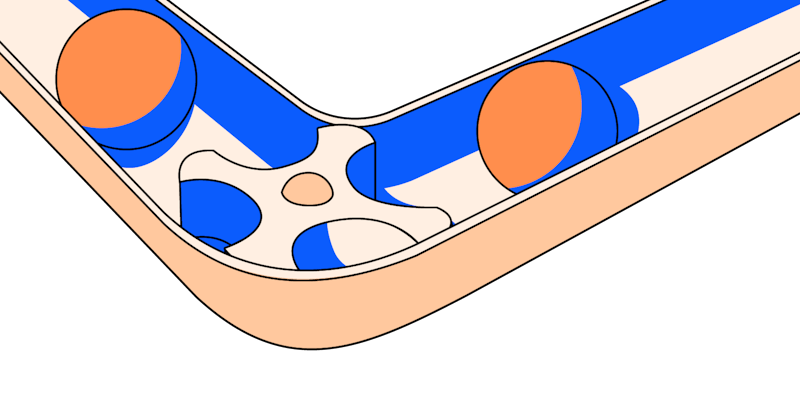
Continuous research is becoming a well-established practice
Most product organizations in our audience are investing time and resources into research and are involving customers early and often in the product life cycle. 78% of respondents believe their company could do more research , yet they still face challenges in running more studies.
Jump to section

The industry is moving towards the democratization of research
64% of respondents report having a democratized research culture , where not only researchers but also designers, product managers, and marketers do research. User interviews, surveys, and product analytics are the most frequently used research methods.

Continuous research enables more effective decision-making
Product teams are using research findings to make more confident decisions. 74% of our audience say research is effective or partially effective in determining decision-making at their organizations . In particular, product teams who conduct research more often report more effective decision-making.
83% of respondents say research should be conducted at every stage of the product development cycle
82% of companies in our audience have at least one dedicated UX researcher
78% of our audience believe their company doesn’t do enough research or could do more studies
Organizations understand the value of research
82% of companies in our audience have at least one dedicated UX researcher. As Lucy Denton , Head of Design at Dovetail , highlights, "it's great to see how far the industry has come in terms of understanding the value of research. Companies are investing more in research which means they’re investing more in customer centricity and building for the customer.”
77% of our audience conducts a new research study at least monthly. In particular, 9% of respondents report running a new research study daily, 38% monthly, and 23% quarterly or yearly. Orgs are investing time and resources in research. Yet, there's still work to do to adopt a continuous product discovery mindset —as only 39% of product teams report having weekly touchpoints with their customers.
At what stages of the product development process does your team gather user insights?
Product teams are putting their customers first and are involving them continuously throughout the product development process
Product teams are involving customers from the start of the product development cycle and continuously throughout the process. In particular, 59% of product teams in our audience conduct research at the problem discovery stage, 57% at the problem validation stage, 55% at the solution generation stage, and 53% at the validation and testing stage.
These results align with what respondents say about the most impactful tasks in their job. These are understanding the customer journey (according to 48% of our audience), discovering unknown/unmet user needs (45%), and validating design assumptions (43%).
“Product organizations need to truly understand their customers to be competitive. With continuous research, they can constantly course-correct to work on the right problem and provide the right solution.” const t="undefined"!=typeof HTMLImageElement&&"loading"in HTMLImageElement.prototype;if(t){const t=document.querySelectorAll("img[data-main-image]");for(let e of t){e.dataset.src&&(e.setAttribute("src",e.dataset.src),e.removeAttribute("data-src")),e.dataset.srcset&&(e.setAttribute("srcset",e.dataset.srcset),e.removeAttribute("data-srcset"));const t=e.parentNode.querySelectorAll("source[data-srcset]");for(let e of t)e.setAttribute("srcset",e.dataset.srcset),e.removeAttribute("data-srcset");e.complete&&(e.style.opacity=1,e.parentNode.parentNode.querySelector("[data-placeholder-image]").style.opacity=0)}} Xiangyi Tang Head of User Research at Pitch
Only 36% of product teams conduct research studies after launch
83% of product professionals in our audience agree that research should happen at all stages of the product development process, yet only 36% of product teams conduct research studies after launch. When product managers are involved in conducting research at organizations, the number of product teams running after-launch research increases to 44%, which indicates that PMs are a key driver of this type of research.
”Many research resources are being put into the design process, problem discovery, and solution testing, but not so much into post-launch reviews,” says Rachel Lynch , Research Manager at Productboard . “I think that’s a huge gap and a missed opportunity because you only know if something will work once you launch it. You should be using those same research tactics to try and figure out if you were successful once something has gone live.”
“We can use different approaches to research to minimize the guesswork before, during, and after we launch a product. Of course, there are constraints, but I would love to use more of the design research toolbox.”
Manager, product manager
“I feel we have so little knowledge about our users, how they interact with our products, and if we're building useful things that I would love to do testing more often.”
Individual contributor, designer
"At every stage, there are possibilities to gain new insights that can affect the solution or problem statement. Being able to see them coming and changing course is key to delivering quality results."
Individual contributor, designer/researcher
“You can always get user inputs and validate ideas through continuous discovery and research.”
78% of product professionals believe their company doesn't do enough research studies or could do more studies
Despite the high demand for research, there are several challenges hindering product teams from running more studies, the main ones being time limitations (according to 64% of respondents), budget limitations (46%), recruiting respondents limitations (31%), and tooling limitations (25%). Unsurprisingly, time limitation is even more constraining when teams don't have a dedicated UX researcher (78% vs. 64%).
“More research isn’t necessarily going to solve the problem of getting the right insights for decision-making," says Rachel Lynch , Research Manager at Productboard. "It's more about quality than quantity and feeling confident that we know what type of research should be used, when, and for what purpose."
time limitations
budget limitations
recruiting respondents limitations
tooling limitations
“We moved beyond trying to convince people of the value of research and now we’re trying to educate people about how to use research in the best way.” const t="undefined"!=typeof HTMLImageElement&&"loading"in HTMLImageElement.prototype;if(t){const t=document.querySelectorAll("img[data-main-image]");for(let e of t){e.dataset.src&&(e.setAttribute("src",e.dataset.src),e.removeAttribute("data-src")),e.dataset.srcset&&(e.setAttribute("srcset",e.dataset.srcset),e.removeAttribute("data-srcset"));const t=e.parentNode.querySelectorAll("source[data-srcset]");for(let e of t)e.setAttribute("srcset",e.dataset.srcset),e.removeAttribute("data-srcset");e.complete&&(e.style.opacity=1,e.parentNode.parentNode.querySelector("[data-placeholder-image]").style.opacity=0)}} Rachel Lynch Research Manager at Productboard
Build the habit of continuous product discovery
With Maze, you can validate every decision with user insights at scale and ship valuable products with confidence.
One researcher to two designers to ten developers
64% of respondents report that their org has a democratized research culture
Three researchers to eight People Who Do Research
The increased demand for research insights has outpaced the bandwidth of most research teams
To understand how product teams are organized, we asked respondents about the number of UX researchers, designers, developers, and People Who Do Research (PWDR) at their organizations.
Our data suggest that the most typical ratio in organizations is one UX researcher for two designers and ten developers. It’s important to note that our survey respondents are largely people who work in SMBs (51-200 employees) and middle-market companies (201-1000 employees) and that 82% of companies in our audience have at least one UX researcher.
If we compare the median number of dedicated UX researchers to the median number of People Who Do Research, we obtain a ratio of three UX researchers to eight PWDR.
Even though many orgs in our audience are investing in research, these results suggest that the high demand for user insights has outpaced the bandwidth of most research teams and that organizations are scaling the impact of research through democratization .
According to the audience we surveyed, in addition to researchers, designers (69%), product managers (54%), marketers (28%), and engineers (10%) conduct research at their companies.
To the question "In your opinion, does your organization have a democratized research culture?" 64% of our audience answered "Yes."
While 37% of companies with one or more dedicated UX researchers say their UX research team is centralized, 63% of companies have a decentralized or hybrid UX research team . This shows that product orgs understand the value of having researchers embedded across teams and enabling those teams to run their own research.
“It's really encouraging to see so many crafts engage in research practice. While I strongly believe that dedicated research professionals are a necessary component for a successful tech company, there will never be enough researchers to cover the range and volume of research needs within an organization. We will always need our teammates to engage in some form of research—whether collaborating with a dedicated researcher or running their own studies.” - Caitlin McCurrie , Research Lead at Atlassian
User interviews and surveys are the most frequently used research methods
User interviews are the most frequently used research method among respondents, with 65% saying they have used them systematically or often in the past 12 months. This is followed by surveys (59%), product analytics (58%), competitive analysis (54%), and moderated usability testing (51%).
Product teams prefer to have a direct dialogue with their users. User interviews are the most used method, but we also see that moderated usability testing is more used than unmoderated usability testing (51% vs. 37%).
“I think these results depend on the method, the rigor, and how easy it is to be adopted by those who are doing research as a small component of their job," says Roberta Dombrowski , VP of User Research at User Interviews . “Many orgs lead with qualitative research first and 1-on-1 interviews when they’re introducing research to their teams, PMs, and designers, and that’s because it’s easier to talk to a customer—it's something we naturally do. It's much harder to do a full card sort study.”
Primary vs. secondary research
Qualitative vs. quantitative research
Evaluative vs. generative research
Qualitative research, primary research, and evaluative research are the most frequently used research types
The most frequently used research types are qualitative research (63% of our audience has used this research type systematically or often in the past 12 months), primary research (54%), and evaluative research (53%).
Primary vs. secondary research When it comes to primary and secondary research, 54% of respondents frequently or systematically use primary research versus 46% for secondary research. The ratio is more similar among researchers (58% for primary research vs. 55% for secondary research).
A possible explanation is that researchers have a better understanding of where to find good secondary research sources and how to consume and synthesize existing data. When it comes to effectively scaling and democratizing research, improving access to primary and secondary research across the org is key.
Qualitative vs. quantitative research Qualitative methods are more frequently used than quantitative methods, with 63% of our respondents saying they always or often use qualitative methods, compared to 51% for quantitative ones.
While qualitative and quantitative research yields different types of data, it's important to remember that these methods are not mutually exclusive and that using them in combination is often the best way to build the right solution.
Evaluative vs. generative research Evaluative research is more common than generative research (53 vs. 33%). While 44% of researchers say they conduct generative research always or often, this percentage decreases to 28% for both designers and PMs. On the other hand, the percentage of respondents who frequently run evaluative research is 62% for researchers, 50% for designers, and 49% for PMs.
“Many teams often get their designers and PMs to run their own evaluative product research, while a researcher's skills are often better placed in doing more generative, strategic research. Research democratization is about enabling the entire product organization to run and observe research, analyze data, and consume the output of research—which creates a healthy way to include the customer's voice in product decisions.” const t="undefined"!=typeof HTMLImageElement&&"loading"in HTMLImageElement.prototype;if(t){const t=document.querySelectorAll("img[data-main-image]");for(let e of t){e.dataset.src&&(e.setAttribute("src",e.dataset.src),e.removeAttribute("data-src")),e.dataset.srcset&&(e.setAttribute("srcset",e.dataset.srcset),e.removeAttribute("data-srcset"));const t=e.parentNode.querySelectorAll("source[data-srcset]");for(let e of t)e.setAttribute("srcset",e.dataset.srcset),e.removeAttribute("data-srcset");e.complete&&(e.style.opacity=1,e.parentNode.parentNode.querySelector("[data-placeholder-image]").style.opacity=0)}} Lucy Denton Head of Design at Dovetail
Design, product, and engineering teams are the main consumers of research
74% of respondents believe research is partially effective (3) or effective (4) in determining decision-making
Product teams who conduct research weekly or daily report more effective decision-making
Designers are the main consumers of research
Product organizations are not only doing research but are also using the findings to inform their decisions. We asked respondents which teams in their orgs rely on product research to make decisions. Unsurprisingly, design (74%) and product teams (67%) are the main consumers of research, followed by engineering (40%), marketing (34%), data (31%), sales (17%), and customer support 16%).
"Today, research is really focused on understanding the user experience,” explains Lucy Denton , Head of Design at Dovetail. "It would be interesting to see how companies evolve to focus more on the customer in other functions like marketing, sales, or customer support. They all talk to customers and need to understand the customers to do their job. I think they are doing research in different ways—they just might not call it research."
“Research at its core is learning. The more research you do and the faster you learn, the faster your decision-making will be.” const t="undefined"!=typeof HTMLImageElement&&"loading"in HTMLImageElement.prototype;if(t){const t=document.querySelectorAll("img[data-main-image]");for(let e of t){e.dataset.src&&(e.setAttribute("src",e.dataset.src),e.removeAttribute("data-src")),e.dataset.srcset&&(e.setAttribute("srcset",e.dataset.srcset),e.removeAttribute("data-srcset"));const t=e.parentNode.querySelectorAll("source[data-srcset]");for(let e of t)e.setAttribute("srcset",e.dataset.srcset),e.removeAttribute("data-srcset");e.complete&&(e.style.opacity=1,e.parentNode.parentNode.querySelector("[data-placeholder-image]").style.opacity=0)}} Roberta Dombrowski VP of User Research at User Interviews
Research positively impacts product adoption, activation, and customer satisfaction
According to our audience, product research has a positive impact on customer satisfaction scores (57%), product/feature adoption (55%), active users (46%), and revenue/profitability (42%).
When asked where product research has the most impact in their organizations, 25% of respondents selected product/feature adoption, 17% customer satisfaction scores, 14% active users, and 12% conversion.
74% of product people believe research is effective or partially effective in determining decision-making at their organizations
We asked our audience to rate how effective product research is in determining decision-making at their orgs on a scale from 1 to 5. When looking at the overall distribution of the effectiveness of decision-making, 74% of respondents report an effectiveness score of 3 (partially effective) or 4 (effective).
In addition, 14% of product professionals in our audience believe research is highly effective in determining decision-making, 9% say it's not effective, and only 3% think it's not at all effective.
As Rachel Lynch , Research Manager at Productboard, explains, "research is not just about what impact it has on your product metrics. It’s about the different decisions it will help companies make—from the big strategic directional decisions to improving usability and those behavioral metrics."
To better understand how orgs inform their decisions based on research findings, we asked respondents whether they agreed or disagreed with a number of statements on a scale from 1 to 5. Here’s what we found:
of respondents agree that in their team, all product decisions are informed by data (agreement score = 3.2/5)
of respondents agree that their organization makes strategic decisions based on product research findings (agreement score = 3.4/5)
of respondents agree that recommendations from research findings inspire new product opportunities (agreement score = 3.4/5)
Product teams who conduct research more often report more effective decision-making
In our survey, we invited respondents to indicate how often their team conducts a new research study and to rate how effective research is in determining decision-making on a scale from not at all effective (1) to extremely effective (5).
When we correlate the frequency of conducting research vs. the effectiveness of research in determining decision-making, we find that product teams who conduct research more often, weekly or daily, report more effective decision-making compared to product teams who conduct research less often, quarterly or yearly (effectiveness score = 3.65 vs. 3.24).
Product teams who conduct research weekly or daily are more likely to report a high effectiveness score compared to product teams who conduct research monthly or less often (56% compared to 48% and 44%). This confirms that conducting research more frequently results in more effective decision-making.
On the other hand, product teams who conduct research quarterly or yearly are more likely to report a low effectiveness score than teams who run research monthly or more often (23% compared to 10% and 7%). This suggests that a lower frequency of research is correlated with less effective decision-making.
Effectiveness score: [1]: not at all effective, [5]: extremely effective
“Once you have more insights on a certain topic and more information about the pros and cons of the options you're facing, there’s a higher chance that the whole team knows more and has higher confidence in decision-making. These results are definitely a good sign that people are not only doing research but also using the findings to inform their decisions.” const t="undefined"!=typeof HTMLImageElement&&"loading"in HTMLImageElement.prototype;if(t){const t=document.querySelectorAll("img[data-main-image]");for(let e of t){e.dataset.src&&(e.setAttribute("src",e.dataset.src),e.removeAttribute("data-src")),e.dataset.srcset&&(e.setAttribute("srcset",e.dataset.srcset),e.removeAttribute("data-srcset"));const t=e.parentNode.querySelectorAll("source[data-srcset]");for(let e of t)e.setAttribute("srcset",e.dataset.srcset),e.removeAttribute("data-srcset");e.complete&&(e.style.opacity=1,e.parentNode.parentNode.querySelector("[data-placeholder-image]").style.opacity=0)}} Xiangyi Tang Head of User Research at Pitch
Accelerate decision-making with deep user insights
With Maze, you can make the right product decisions faster and with confidence by infusing them with user insights generated across the entire product development cycle.
The Atlassian Way: Research is a marathon, not a sprint

Caitlin McCurrie
Research Lead at Atlassian
Atlassian has a world-class research team, with nearly 100 researchers and a wide diversity of perspectives and backgrounds–from anthropologists to psychologists to survey experts and more. Even with such a large and ever-growing team , there are not enough researchers to address the many questions from the organization across our product development cycles. To extend the power of our research team, we collaborate with our cross-functional colleagues to conduct research as a team and empower Atlassians to conduct their own research when they might not have a research partner yet.
Despite such diverse backgrounds engaging in research, we’re consistent in how we orient our research process to the lifecycle of a product. Atlassian research is aligned with the Atlassian playbook for creating products or services: The Atlassian Way .
The Atlassian Way has four stages: Wonder, Explore, Make, and Impact. Across these stages, we continuously collect insights using different methods to keep the customer at the center of our decision-making across the development journey and build confidence that we are on track to deliver a quality experience.
Insights here are critical to defining the problem space. Without a clear understanding of the customer needs or pains, you risk investing significant development time and resources into building a product that doesn’t deliver value. Typical research activities include semi-structured interviews, observational studies, and surveys.
Research in this phase helps ensure that you create solutions that actually address your customer’s challenges. Conducting research, such as concept or usability testing, during your exploratory phase maximizes the likelihood you find the best solution that offers utility for your customers.
It's important to assess the utility and ease of use of your final solutions since these are strong predictors of usage and adoption. Explore activities like usability studies or a diary study of your beta participants. Also, try to triangulate qualitative data with behavioral analytics to strengthen the quality of your insights.
Collecting insights at this stage will help you understand the “why” behind the success (or failure) of your newly released product. Atlassian researchers work closely with their analyst peers to offer context to better understand behavioral analytics and identify improvements for later iterations.
Inspired to implement The Atlassian Way in your research practice? Whether you’re implementing your first research practice or optimizing the existing process, we have two key messages for you from our experience of maturing research at Atlassian.
Research is a team sport.
Product managers, designers, and product marketers all participate in research at Atlassian. While the researcher brings best practices, each team member brings their unique perspective to our insights and what they mean for the product we’re developing. We encourage all crafts to lead their studies. While this can feel intimidating for those new to research, not all studies need not be lengthy and complicated. For example, for Atlassians-who-do-research, we recommend exploring open comment fields of a CSAT survey, creating a poll in a community space, or walking through paper prototypes with five customers.
Research is a marathon, not a sprint.
Research isn’t confined to one stage of the product development process, such as discovery or validation after shipping, but is a marathon that extends across the entire product life cycle. Rather than thinking of individual studies that generate customer insights, we create continuous learning cycles that contribute to an ever-growing knowledge base of who our customers are and how we best serve their needs. The Atlassian Way ensures that we continuously deliver insights that allow teams to course-correct as they build.
Methodology and audience insights
The report survey was created using Maze and distributed between June 21 and July 31, 2022. During that period, we shared the survey on our Maze website, social media accounts, in our monthly newsletter, and via email to our contacts, who also shared the survey with their professional networks and in research and product communities.
We partnered with ADPList , who promoted the survey in their global community of over 8000 mentors and learners. We collected responses from 603 product professionals with experience conducting research (researchers, designers, and product managers). Other 564 respondents took the survey but did not qualify based on our criteria.
Which of the following most accurately describes your role?
How many people work at your company?
How many people are in your product org?
Continuous research is here to stay
Product teams understand the value of research and the importance of building products with their customers. Yet, the biggest obstacle keeping companies from running more research is a lack of time. The challenge is no longer getting buy-in but how to conduct research more often and throughout the product life cycle.
Democratizing research will help scale the impact of research
The demand for customer insights has outpaced the capacity of most research teams. As a result, companies are starting to amplify the impact of research by empowering more teams across the organization to access, collect, and consume research insights to make more informed decisions.
Conducting research early and often improves decision-making
Product teams report that research positively impacts product adoption, activation, and customer satisfaction and helps make more effective decisions, especially when conducted weekly or daily. We think research findings will continue to be a key factor in informing decision-making at each stage of the product life cycle.
Maze is the user research platform that makes products work for people by making user insights available at the speed of product development. Built for ease of use, Maze allows designers, product managers, and researchers to collect and share user insights when needed most, putting them at the center of every decision.
2023 Continuous Research Trends Report
UX Research In 2023: Patterns And Trends To Keep An Eye On
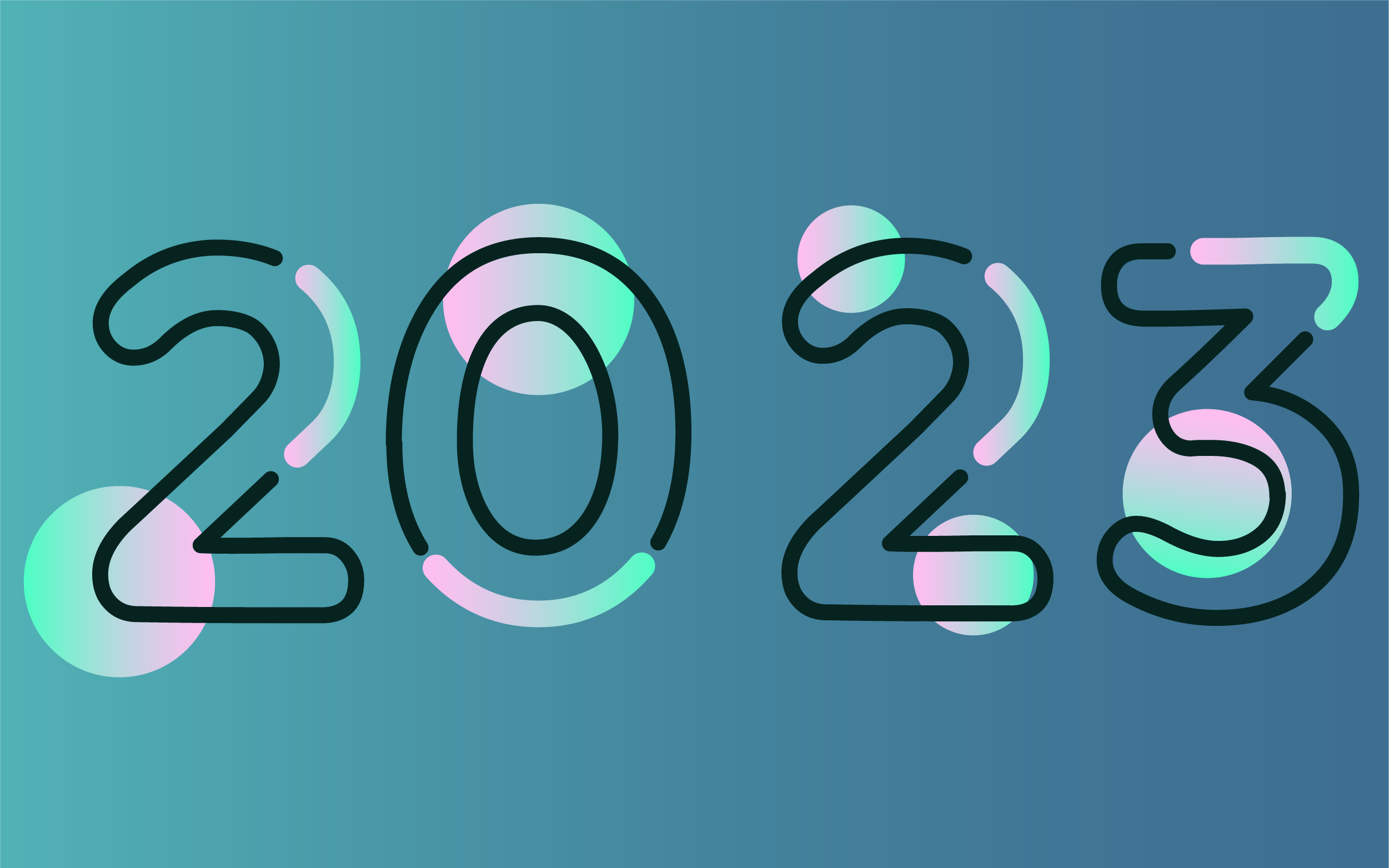
Posted by AnswerLab Research on Oct 26, 2022
At AnswerLab, our team is always keeping an eye out for patterns and similarities across clients to surface trends in the field, from methodological focuses to bigger priorities. As you look to 2023, check out the trends we’re seeing across our research now and consider how your team will address them next year.
UX research for employee experience
For the past few years, we've been conducting research on workplaces , and this topic is becoming more and more common with our clients as well. Teams come to us with questions like “How do we break down silos across product teams and work more effectively?” or “How is our workplace serving our teams’ needs as we return to in-person work?” Other studies focus on the internal experience at call centers or with customer service teams.
Recently, we’ve been working with some clients on how to create better research operations practices, from file structures to project organization and naming conventions. For these kinds of studies, we’re speaking with internal stakeholders to identify where we can make improvements; all without looking at a single external product or experience.
Acquiring a new product? Bring in UX research to understand the landscape
While this particular trend reaches a smaller group of teams, this year we’ve seen the increasing value of research following the acquisition of a new product or company. Some clients of ours have come to us following an acquisition for help answering a range of questions, from “What are the best use cases and attributes of this new product for our existing users?” to “Where do we put this on our website?” to “How do we talk about this acquisition in a way that isn’t off-putting and helps us maintain our brand vision?”
UX research with your end users can help you develop a better understanding of brand impression and address more tactical questions about how to incorporate your new product into your existing ecosystem. Additionally, some of our clients have expressed that working with a third party like AnswerLab helped diffuse tension amongst merging teams as a neutral resource throughout the process.
Teams are thinking more deeply about how to build inclusive and diverse workspaces.
In 2020, corporate leaders issued countless statements decrying racism and promising to invest in diversity, equity, and inclusion efforts. But some actions on these commitments have been less visible than promised, especially when it comes to hiring. Biased, false, and racist statements like, “We don’t want quality to suffer,” and “There’s no pipeline, these folks just aren’t out there” are unfortunately commonplace. So what can you do to help your team overcome these biases and build a more diverse team?
First of all, having a diverse team is a creative advantage. What we gain through diversity conscious hiring is a plethora of lived experiences and cultural awareness that we may not have otherwise had, or been able to access, by a homogenous team makeup. Diverse teams also enable you to discover and call out potential problem areas related to product inclusivity, which may have gone unchecked during the product development process.
We’re seeing a number of clients and folks in the UX community talking about how we can build more diverse and inclusive work environments. Our Director of DEI, Shakima Jackson-Martinez, recently presented on this topic at two different UX conferences, and shared a few key learnings. First, start by benchmarking the racial and ethnic diversity of your current team, and evaluate prior applicants for open positions from the past year to understand where things may be going wrong. This will help you understand the reasons for the current makeup of your team. Have open and honest conversations within your team and with leadership about the diversity of your team or lack thereof. And make an action plan that holds your hiring decision makers accountable!
A renewed focus on building appropriate technology experiences for our youngest users
Earlier this year, we shared that companies are shifting their focus to children and youth to build age-appropriate experiences for young users. Internationally, advocacy organizations been amplifying the UN's call for tech companies to invest in building experiences that meet the unique needs of children online. And just last month, California passed brand new legislation requiring online experiences to implement wide-ranging protections for young users. This is the first of its kind in the U.S. and will apply to a range of digital products from social media to gaming platforms when it takes effect in 2024. We expect to see intensified investment to ensure digital experiences align to these important new standards for our sector. If your product or service is accessible by young users, now is the time to start the conversation with diverse stakeholders, and explore how your design and research practices will need to evolve to more fully center the needs of children and youth.
Taking the next step in product accessibility
Heading into 2023, accessibility continues to be a strong priority for clients across the board. As always, we recommend leveraging accessibility research throughout your product development cycle to ensure you’re creating experiences that work for everyone. But recently, we’ve been hearing from clients who feel ready to take the next big step in accessibility. Most people think of hearing or vision impairments when it comes to accessibility concerns, but what comes next? Are you making sure you’re also considering those with cognitive impairments or motor impairments? How are you promoting empathy with stakeholders for users who need accessibility accommodations? As you plan for your accessibility roadmap in 2023, think bigger about who you’re including and who you aren’t to deepen your approach.
Evolving what inclusive research means
Here at AnswerLab, we’ve invested a lot of time in building inclusive research practices and we work with many of our clients on experience gap research and inclusive research . Teams who have been prioritizing inclusive research for a while are starting to move from this idea of recruiting people based on clear aspects of identity to thinking about how we can account for intersectionality. Going into a session and asking someone, “How do you experience this onboarding as a X person?” doesn’t work, because people don’t think about themselves in such a narrow way. People are a constellation of identities and experiences, and it can be limiting to oversimplify identity research. It’s critical to think deeply about who you’re recruiting, what kinds of questions you’re asking of them, and how you might make room for the many dimensions of a participant’s identity. This is complex and multifaceted, and depending on your study, the answer to how you approach this is going to be different.
Upskilling takes on a new focus
More and more of our clients are looking to help their internal teams upskill, and not just within their research departments! Many of our clients are looking for training opportunities for product and design functions on how to better collaborate with research. For example, we recently worked with a DEI team on a large research initiative internally around inclusion in their products. To help them build a deeper understanding of UX research, we hosted trainings and workshops to help this group of copywriters, designers, and product teams learn how to partner with UX teams and make a bigger impact. This is a part of a larger trend of research teams breaking out of old silos and getting a larger seat at the table.
Do these sound familiar to you and your team? Get in touch with a strategist to hear how AnswerLab can help.
AnswerLab Research
Related insights.
This week, we hosted accessibility experts from Wells Fargo and Google in our San Francisco office to talk about all thi...
As 2019 comes to a close, we’re taking a moment to reflect on how UX research evolved this year. Across clients, industr...
We’ve been hearing a lot of discussion in the UX community about the importance of accessible research and design. But t...
stay connected with AnswerLab
Keep up with the latest in UX research. Our monthly newsletter offers useful UX insights and tips, relevant research, and news from our team.
Staying ahead of the curve: Using UX research to keep up with trends
Last updated
3 July 2023
Reviewed by
Jean Kaluza
UX researchers are experts in adapting their methods on the fly thanks to:
Better access to newly emerging technologies
Alterations in popular research techniques
Increased interest in exploration and experimentation
UX professionals are essential to any productive and innovative team. Those who keep up with the latest trends get the opportunity to improve their skills, their company’s overall product quality, and customer satisfaction .
A good UX researcher applies correct methodologies and understands and adapts to limitations. A great UX researcher seeks new technologies and trends to inform and expand their portfolio.
Created with great researchers in mind, here’s our guide to everything new in UX research in 2023. Let’s get into it!
Don't let UX problems go unnoticed
Use Dovetail to analyze all your customer interviews and uncover hidden UX issues that are costing your business every day.

- UX research: An ever-changing field of innovation
Over the past few years, the role of user experience (UX) research in product development has moved from “nice to have” to an essential component of any brand’s long-term success.
UX research studies your customers’ needs, wants, experience with your brand, and more.
Gathering qualitative and quantitative data about your company’s top customers is the first step to understanding them.
Interpreting customer feedback can reveal crucial insights. This can lead to a clear path forward for your company’s future product launches and desired feature improvements.
Depending on your company’s research strategy and niche, the collection methods for UX research vary greatly. Traditionally, some of the most common methods include:
Customer interviews
Focus groups
User testing
A/B testing
While leading UX experts are still using these strategies, changes in our social and economic climate have led to advances in other areas of UX research.
UX researchers will always be kept on their toes as their industry is ever-changing.
- The benefits of staying current with UX research trends
UX research changes traditional approaches to product development, bringing innovation into the workplace. Many companies experience plenty of benefits from integrating even small amounts of UX research strategies into their existing plans.
As more businesses make the switch, UX researchers need to continually evolve and improve to be the best of the best.
The magic truly begins when a company applies this cutting-edge mentality to its UX research practices. This approach allows a company to:
Stay ahead of the competition
No matter what industry your company works in, you definitely have competitors trying to out-sell and out-provide to your top customers.
Don’t let them overtake your place in the market by failing to keep up with UX research best practices. Instead, use research trends to stay ahead of your competition and better serve your target audience.
Challenge the status quo
Has your team become complacent and lacking in innovation? Continual success can lead to internal complacency.
While sticking to what you know often feels safe and comforting, it’s not the best way to continually grow your business.
Keeping up with UX research trends challenges your practices and encourages your team to improve their approach as well. This can push them toward increased creativity and innovation.
Offer your clients the best of the best
UX research focuses on getting to the bottom of your customer’s true desires and pain points. This is a great way to uncover helpful feedback that guides future product features.
Modernizing your UX research strategy ensures you become highly attuned to what makes your target audience happy.
When it comes time to pitch a new product, the question turns from “Will our audience want this?” to “How badly will our customers need this?”
This powerful switch allows your team to produce only the best quality products, improving your bottom line, enhancing your reputation, and boosting the customer experience .
Become a leader in your chosen niche
Acting as your client’s crystal ball into what their target audience is looking for, conducting high-quality UX research helps your clients become a leading voice and resource within your chosen industry.
Being a leader involves ongoing growth and a willingness to experiment. Continual education on UX research trends and technologies enables your team to brand themselves as experts within your niche. And high-quality customers naturally gravitate toward niche specialists.
- Ten emerging UX research trends you should be aware of
2023 has been a big year for UX research innovation, and we’re only just entering the second half!
Being aware of the latest UX research trends is key to providing the best value to your business and positioning yourself as a valuable, engaged team member. Knowing how these trends will impact your team in the coming years can help you future-proof your projects.
Improve your UX research knowledge and your team’s UX strategy by getting familiar with ten of the most influential themes that are emerging in the field this year:
UX research tools are improving company results
Without a doubt, companies investing in UX research are seeing the biggest return on investment so far in 2023.
For example:
By prototyping UX design options, Bank of America exceeded its ROI benchmark and doubled the number of customers enrolled in its online banking service.
After implementing a company-wide UX research initiative, General Electric noticed a 100% increase in development team productivity. This change saved the company multiple millions of dollars in resources and labor.
Open communication about UX research benefits needs to be a key focus of your internal strategy. Team buy-in to the process is essential for external success, so highlight your accomplishments and showcase the results you earn through your work.
How to use this UX trend to your advantage:
If you receive pushback from management about the importance of UX research, provide detailed quantitative results as part of your pitch.
High-quality UX research will produce great results, and researchers who can accurately convey the value to their team will improve the overall outcomes of their department and the company.
User-centered design is incredibly popular
User research is becoming an essential component of every level of product development, but this is particularly true for design choices.
UX design taps into user research to create products and marketing tools for your target audience’s specific needs, wants, and quirks.
However customers interact with your brand, you want to provide an empathetic and personalized experience that leaves them coming back for more. That means tailoring your website, social media advertisements, and products to your customers.
As the expectations for brands to perform continues to increase, companies who forego user design research will quickly be left behind. Lean into this need as much as possible when seeking support for UX research efforts.
User-centered design is more than aesthetic colors on your website and adding features your customers want.
Run detailed user experience questionnaires regularly with tools like customer feedback surveys . Your projects’ level of user understanding can become incredibly specialized and prime for competitive strategy.
As a result, your top customers will fall even more in love with your brand’s UX research.
Accessibility and inclusivity are more important than ever
Did you know that 42% of American adults don’t feel represented in modern advertisements?
An inclusive approach to product development and user experience opens your business to a wider and more diverse audience. It also positions your team as an industry leader.
Even if your brand functions within a very specific niche, you can always enhance your offerings to be more inclusive to the wide range of people in your target audience.
To improve your customer experience and get the most out of your UX research efforts, conducting accessibility testing using inclusivity standards is an absolute must.
As the world continues to move in a more inclusive direction, UX researchers also need to step up. Encourage your team and company to find ways to make your products, online presence, and overall business mission more inclusive.
Researching your target audience and getting direct accessibility and inclusivity feedback is a great way to start your journey toward improving your user experience for all.
Customer retention and engagement are key areas of focus
Unsurprisingly, holding onto high-quality customers is a fantastic tactic for long-term brand growth and financial success.
The cultural and social landscape of digital marketing and media continues to shift to a more convenient and personalized experience. Top-performing brands are using skilled UX researchers to find unique, creative ways to build a strong sense of customer loyalty .
Some of the most well-known brands in the world have mastered this strategy, and the results speak for themselves:
Need a quick coffee? Better grab a Starbucks , as they offer a comprehensive loyalty program to keep you coming back for more.
Scrolling through social media? You’ll likely see a witty comment from Wendy’s that makes you laugh—and hey, you are feeling kinda hungry, actually!
To further improve customer retention , companies should perform two primary tasks:
Collect specific data on what your customers love about your brand
Use this data to design a creative customer loyalty program that matches your brand
Retention strategies can range in complexity from resale email newsletters to tiered subscription or rewards programs.
Brainstorm with your team and find a unique option to serve your brand as a sought-after perk for your target audience.
Detailed UX research leads to smarter strategies
Imagine it’s time to pitch a new product. What if you could just sort through a list of winning ideas instead of guessing what your customers would like?
For UX researchers and product developers, customer insights are worth their weight in gold (literally).
Instead of wasting countless resources during the early stages of product development on figuring out which direction to take, UX research allows your team to crack the code. You can discover what your customers are actually looking for.
Better yet, qualitative studies that explore the motivations and goals of users can keep your product and clients on track for the duration of your user’s journey. These studies answer the “why,” while many companies focus on the “what” and “when” of quantitative data .
Stay ahead of mistakes and save your team a ton of time and effort by focusing your energy and efforts on products that fit the customer insights you’ve collected. It’s an easy way to reduce risk and build brand loyalty.
Your business needs to stay clear of “intuition” and “hunches” to get the most out of your UX research efforts. Allow your data and users to lead the way.
“The user breaks the tie” can be a helpful comeback to any internal disagreement. Your CEO, sales team, and developers need to be on the same page about the importance and power of customer insights. Once you achieve this, the results will blow you away!
Machine learning and AI in UX research are on the rise
If you’ve paid attention to the latest news in the tech sector, you’ve probably heard about the explosion of machine learning and AI practices across almost every industry.
AI is coming for UX research , too. According to a recent Forbes Advisor report, 64% of business owners in 2023 believe that AI can improve customer relationships and satisfaction.
The benefits of AI include:
A better understanding of customer insights
Quick sorting through large amounts of research
Streamlining your process
Improving behavioral prediction and data analysis
Undoubtedly, AI will play an increasingly important role in customer research as the years continue. Our advice is to stay informed and be willing to try new things, but don’t jump in too quickly.
While there’s nothing wrong with experimenting with this new technology, no machine can replace true human interaction and connection. And that’s the foundation of all great UX research!
So don’t be afraid to try new tech as it becomes available, but ensure it enhances your systems rather than replacing them completely.
UX researchers are becoming internal educators
As we mentioned before, companies that get the best results from their UX research efforts incorporate customer insights into every level of their business. An easy way to achieve this outcome is to increase the involvement of UX researchers.
UX professionals can integrate nicely into other silos, such as customer service, marketing, copywriting, and development. Having UX researchers sit parallel or within the same physical space as these different departments can create synergies and more organic feedback loops.
Results can include:
Developers having a much better hand in what they build, improving feasibility
Customer service teams can include exit surveys to learn why users are leaving
Marketing can be a much better narrator and attract participants to research
UX research can enhance every department of your company in countless ways.
Long gone are the days of UX researchers acting as skilled solo technicians in isolation from other teams within a company. Now, more than ever, UX researchers are getting the opportunity to support and educate their peers on best practices. And that’s a win for everyone!
If you’re a UX researcher, advocate for participation in important company meetings and decisions. Your insights and understanding of the customer are essential, so your opinion should shape all levels of company decisions.
Additionally, UX team members should be encouraged to share educational training sessions to change the business culture slowly (but surely). This can align everyone’s values with the importance of UX insights and customer feedback .
Virtual research is the new norm
During 2020–2022, virtual meetings rose in popularity from 44% to 78% —and this seems like a change that’s here to stay.
Being online is a standard part of our lives for most of us. So it’s no surprise that companies move their customer surveys and interviews in that direction, too.
In-person interviews and focus groups offer valuable insights that researchers can’t always collect by virtual means. It can be really tricky to read someone’s body language over Zoom, for example. Still, the convenience and accessibility of virtual research tools beckon.
Whether you send email survey links or host one-on-one virtual interviews with your customers, integrating online options into your UX strategy is a must.
If you’re looking to dive into virtual UX research tools , we recommend taking extra time to fine-tune your interview or survey questions.
Your customers will complete most online surveys without support, so it’s easy for confusion to arise if your questions are unclear.
UX research is improving and optimizing small decisions
Efficiency and productivity are hot buzzwords when it comes to product development. Spending extra time on UX research is one of the best ways to achieve these goals.
No matter the size of your team, clashing personalities, opinions, and value systems will inevitably slow progress. This is a normal part of collaboration, but it can also lead to delays, increased stress, and burnout. What’s the solution?
Top-performing teams use UX research to reduce the risk of getting stuck on the small stuff.
With unlimited access to detailed customer insights, your team can quickly turn small (and potentially stressful) decisions into strategic moves based on your customers’ needs and wants.
This approach helps align your team to one common goal, which boosts efficiency and productivity. Most importantly, you can create a product that better serves your audience.
During decision-making meetings, start by highlighting the key customer insights that will guide your team’s decisions. It’s an easy way to keep everyone on track, moving towards the same joint goals, and away from unnecessary arguments.
Continuous UX research is (essentially) a requirement
Gone are the days of simply copying your competition. If your team isn’t continuously conducting customer research, you may already be falling behind.
For the best understanding of how your company is performing, you need to have current and accurate data flowing in at all times.
In this social media age, public opinion of your brand can change overnight. Staying on top of UX research gives your team the best chance to respond to changes as soon as possible.
Additionally, continuous research ensures you’re staying current with the needs and wants of your ever-changing customer base.
If possible, automate parts of your UX research outreach to prevent dry spells in data collection .
Did a customer buy a new product? Have an automated survey sent out a day after purchase.
Offer a subscription service-based product? Ask for feedback after three and six months of use.
- Level up your UX research strategy with Dovetail
The first half of 2023 has shown us that UX research is quickly becoming one of the most important tools companies can use to enhance their growth.
Using Dovetail , you can bring together all your customer research and uncover insights that will change how you build products and serve your customers for the better.
Should you be using a customer insights hub?
Do you want to discover previous user research faster?
Do you share your user research findings with others?
Do you analyze user research data?
Start for free today, add your research, and get to key insights faster
Editor’s picks
Last updated: 25 June 2023
Last updated: 18 April 2023
Last updated: 15 January 2024
Last updated: 27 February 2023
Last updated: 24 June 2023
Last updated: 29 May 2023
Last updated: 14 March 2023
Last updated: 19 May 2023
Last updated: 30 April 2024
Last updated: 13 April 2023
Last updated: 7 July 2023
Last updated: 3 June 2023
Last updated: 11 January 2024
Last updated: 13 May 2024
Latest articles
Related topics, .css-je19u9{-webkit-align-items:flex-end;-webkit-box-align:flex-end;-ms-flex-align:flex-end;align-items:flex-end;display:-webkit-box;display:-webkit-flex;display:-ms-flexbox;display:flex;-webkit-flex-direction:row;-ms-flex-direction:row;flex-direction:row;-webkit-box-flex-wrap:wrap;-webkit-flex-wrap:wrap;-ms-flex-wrap:wrap;flex-wrap:wrap;-webkit-box-pack:center;-ms-flex-pack:center;-webkit-justify-content:center;justify-content:center;row-gap:0;text-align:center;max-width:671px;}@media (max-width: 1079px){.css-je19u9{max-width:400px;}.css-je19u9>span{white-space:pre;}}@media (max-width: 799px){.css-je19u9{max-width:400px;}.css-je19u9>span{white-space:pre;}} decide what to .css-1kiodld{max-height:56px;display:-webkit-box;display:-webkit-flex;display:-ms-flexbox;display:flex;-webkit-align-items:center;-webkit-box-align:center;-ms-flex-align:center;align-items:center;}@media (max-width: 1079px){.css-1kiodld{display:none;}} build next, decide what to build next.

Users report unexpectedly high data usage, especially during streaming sessions.

Users find it hard to navigate from the home page to relevant playlists in the app.

It would be great to have a sleep timer feature, especially for bedtime listening.

I need better filters to find the songs or artists I’m looking for.
Log in or sign up
Get started for free
Insights AI
The State of User Research in 2023 and Beyond! [Stats & Trends to Watch]
Discover the latest stats and trends shaping user research in 2023 and beyond. Gain insights for effective decision-making and strategy development.
As user demands and expectations evolve, conducting UX research becomes increasingly essential, particularly during a recession. In Q2 of 2023, it is imperative for leadership to recognize the value of deep user insights in decision-making and the creation of successful products.
If you aim to stay ahead of the competition and effectively meet evolving user needs, this eBook is a valuable resource for you.
This eBook has 11 powerful emerging UX research trends that you can hop on to give users what they need. Also, it will help you recession-proof your UX research plan.

Enter your details to gain access to our entire ebook for an insightful read!
Got a question? Check out our FAQ’s
.png)
Get your Product Pack Design tested against competitors
Book a demo.
- This is some text inside of a div block.
- Reviews / Why join our community?
- For companies
- Frequently asked questions
User Research
What is user research.
User research is the methodic study of target users—including their needs and pain points—so designers have the sharpest possible insights to make the best designs. User researchers use various methods to expose problems and design opportunities and find crucial information to use in their design process.
Discover why user research is a crucial part of the design process.
- Transcript loading…
User Research – Get to know your Users, and What They want
To call user research a crucial part of an interaction design process might seem overly obvious. Indeed, it’s the only way to discover exactly what these users need, having first found out precisely who they are. To set out to generate these facts, you must gather data from your users through a structured approach . First, you must choose methods that 1) suit your research’s purpose and 2) will yield the clearest information. Afterwards—to get the insights you want—you’ll need to interpret your findings from all that data, which can be tricky . You can apply user research anytime during the design process. Typically, researchers begin with qualitative measures, to discover users’ needs and motivations . They might later test their results by using quantitative measures .
“Research is creating new knowledge.” – Neil Armstrong, the First person to walk on the Moon
User research essentially splits into two subsets:
Qualitative research – Ethnographic field studies and interviews are examples of methods that can help you build a deep understanding of why users behave the way they do (e.g., why they leave a website so quickly). For instance, you can interview a small number of users and get sharp insights into their shopping habits by asking them open-ended questions. Usability testing is another dimension of this type of research (e.g., examining users’ stress levels when they use a certain design). Qualitative research requires great care. As it involves collecting non-numerical data (e.g., opinions), your own opinions might influence findings.
Quantitative research – With more-structured methods such as surveys, you gather measurable data about what users do and test assumptions you developed from qualitative research. An example is to use an online survey to ask users questions about their shopping habits (e.g., “Approximately how many items of clothing do you buy online per year?”). You can use this data to find patterns within a large user group. In fact, the larger the sample of representative test users is, the more likely you’ll have a statistically reliable way of assessing the target user population. Regardless of the method, with careful research you can gather objective and unbiased data. Nevertheless, quantitative data alone cannot expose deeper human insights.
We can also split user research into two approaches:
Attitudinal – you listen to users’ words (e.g., in interviews).
Behavioral – you watch their actions through observational studies.
Usually, you can get the sharpest view of a design problem when you apply a mixture of both quantitative and qualitative research as well as a mixture of attitudinal and behavioral approaches.
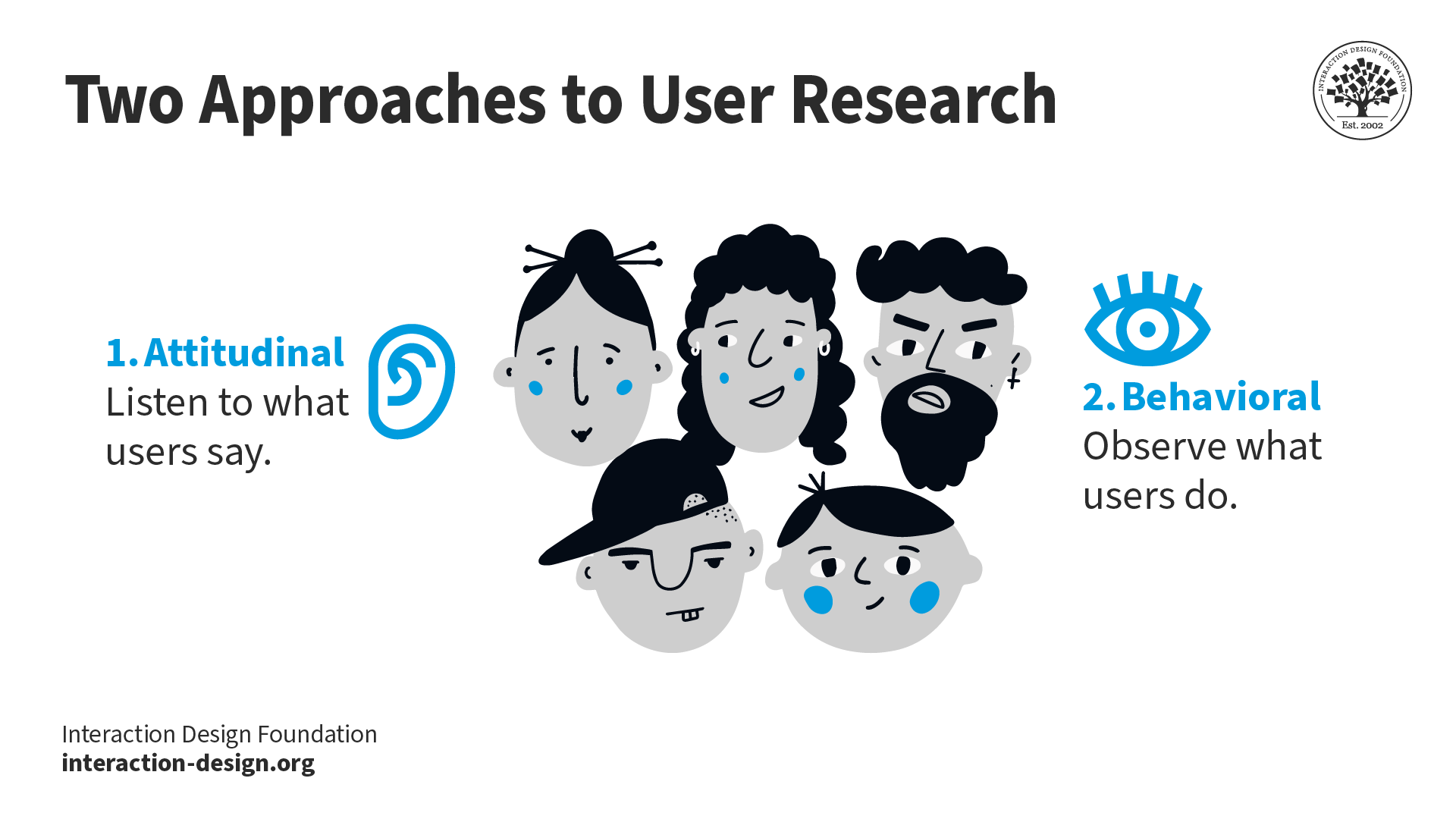
© Interaction Design Foundation, CC BY-SA 4.0
Leverage User Research Methods throughout Development
Industry-leading user experience consulting organization the Nielsen Norman Group names appropriate user research methods for you to use during your project’s four stages . Here are key methods:
Discover – Determine what’s relevant for users.
Diary studies – Have users log their performance of activities or record their daily interactions with a design.
Contextual inquiries – Interview suitable users in their own environment to find out how they perform the task/s in question.
Explore – See how to address all users’ needs.
Card sorting – On cards, write words and phrases and then let participants organize these in the most meaningful way and label categories to ensure your design is logically structured.
Customer journey maps – Create user journeys to reveal potential pitfalls and crucial moments.
Test – Evaluate your designs.
Usability testing – Make sure your design is easy to use.
Accessibility evaluations – Test your design to ensure everyone can use it.
Listen – Put issues in perspective, uncover any new problems and spot trends.
Analytics – Gather analytics/metrics to chart (e.g.) website traffic and generate reports.
Surveys/Questionnaires – Track how users’ feel about your product/design via these.
- Copyright holder: Unsplash. Copyright terms and license: CCO Public Domain. Link: https://pixabay.com/en/clay-hands-sculpting-art-69...
- Copyright holder: Unsplash. Copyright terms and license: CCO Public Domain. Link: https://www.pexels.com/photo/man-in-black-shirt-an...
- Copyright holder: Indecent Proposer. Copyright terms and license: CC BY-NC 2.0 Link: https://www.flickr.com/photos/indecent_proposal/14...
- Copyright holder: Anna Langova. Copyright terms and license: CC0 1.0 Link: http://www.publicdomainpictures.net/view-image.php...
- Copyright holder: Conmongt. Copyright terms and license: CC0 Public Domain Link: https://pixabay.com/en/hourglass-time-time-lapse-clock-1623517/
However you approach user research, always consider the pros and cons of each technique . Card sorting is cheap and easy, for example, but may prove time-consuming when you proceed to analysis. Moreover, it might not provide in-depth contextual meaning. The resources available to you are another constraint. These will decide when, how much and which type of user research you can actually do. Therefore, carefully choose only the most relevant method/s for your research . Also, get stakeholders from your organization involved early on . They can reveal precious insights and help keep your research on track regarding business goals. Overall, user research is a valuable way to validate the assumptions the design team makes concerning users in the field , cut the expense of the best deliverables and keep your product’s demand high and ahead of competitors’ in the marketplace.
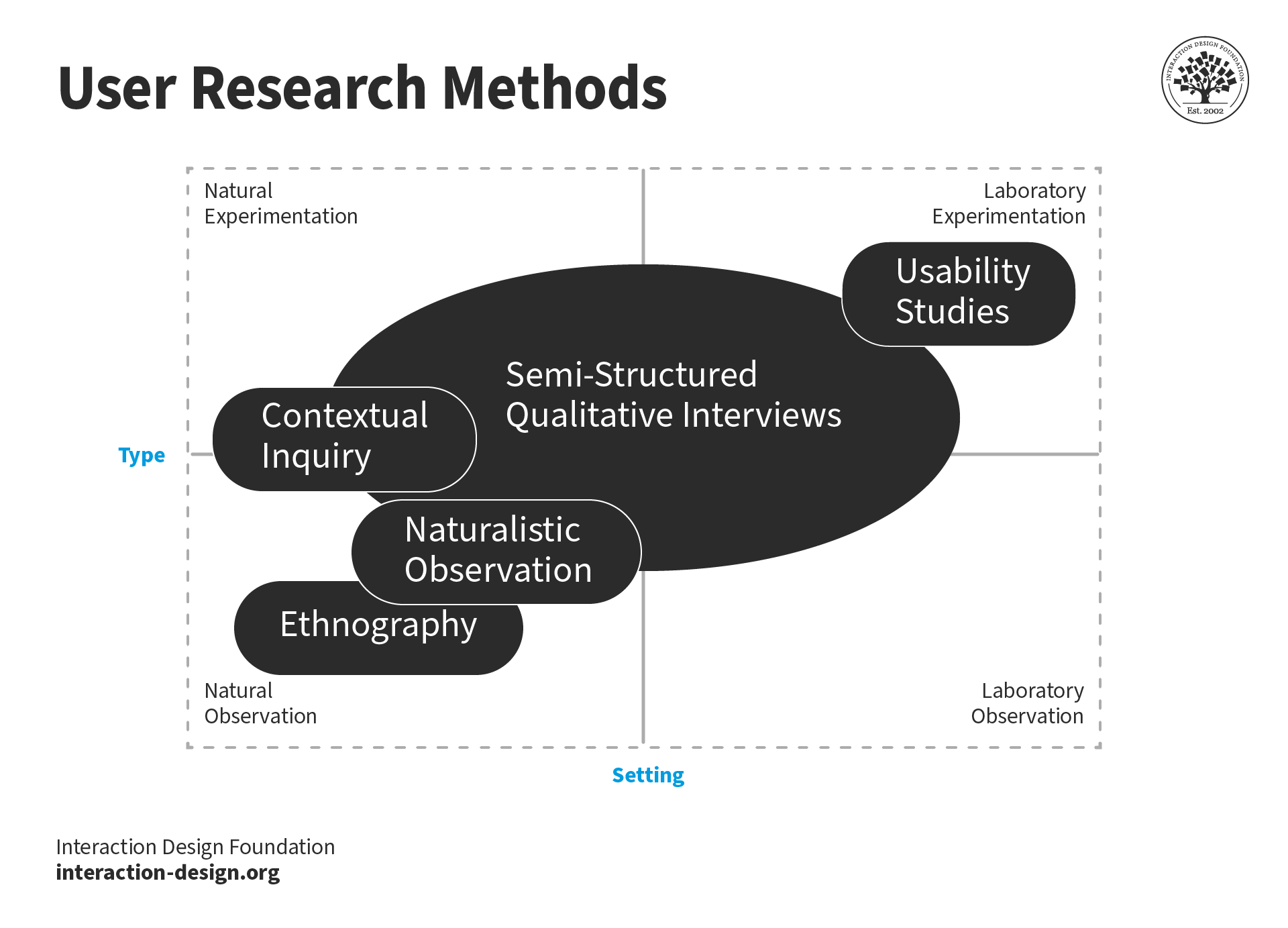
User research methods have various pros and cons and involve activities ranging from observations of users in context to controlled experiments in lab settings.
Learn More about User Research
For a fuller grasp of user research, take our course here .
See the Nielsen Norman Group’s list of user research tips .
Find an extensive range of user research considerations , discussed in Smashing Magazine.
Here’s a convenient and example-rich catalogue of user research tools.
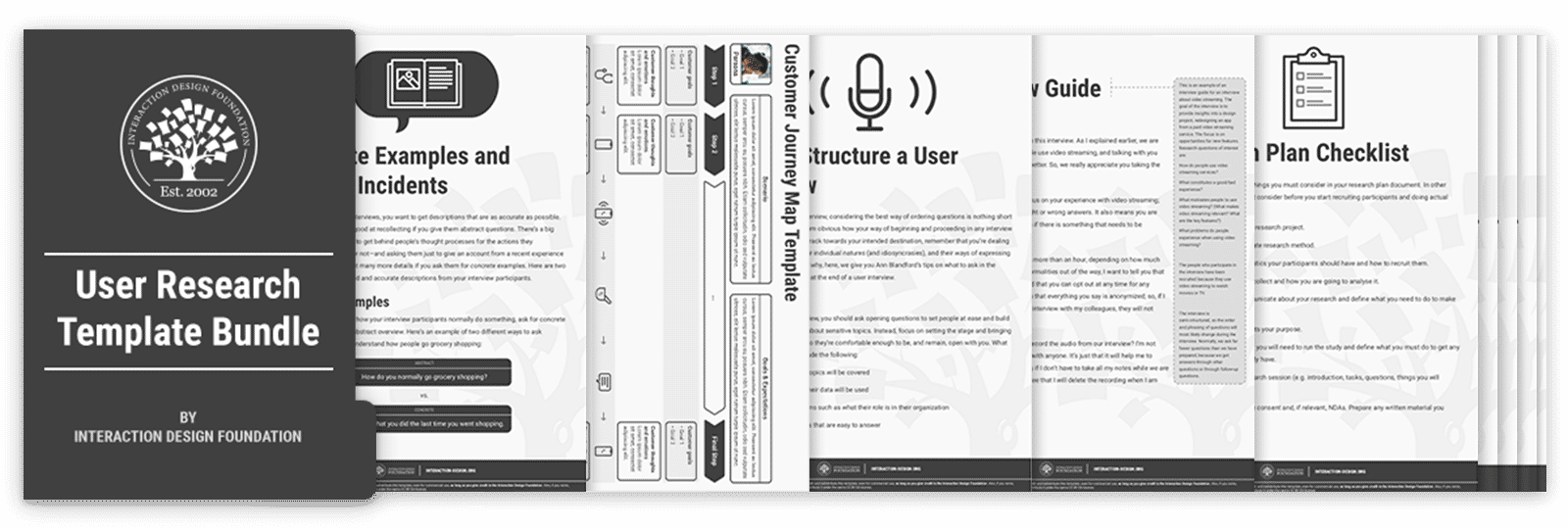
Questions related to User Research
User Research is a fulfilling career for individuals driven to comprehend user behaviors and work collaboratively with teams. As a User Researcher, you're instrumental in steering teams towards crafting user-centric solutions. If you're intrigued by a career that combines both analytical and creative insights, consider delving into this field. For a comprehensive understanding, explore the User Researcher Learning Path on our platform.
User Researchers are seeing competitive pay in the industry. On average, they can earn from $92,000 to $146,000 annually. In some smaller firms, user research duties might be combined with a broader UX role. To understand how salaries can differ by region or delve into a broader perspective on UX-related pay, check out this detailed guide on UI UX Designer Salaries for 2023 or Glassdoor's breakdown of User Experience Researcher salaries .
While both are integral to the user experience, User Research and UX Design serve different purposes. User Research delves deep into understanding user preferences and needs, paving the way for informed design strategies. In contrast, UX Design is about sculpting a product based on that insight, ensuring it's both user-centric and aesthetically pleasing.
Sometimes, especially in compact teams, the roles might blur with a designer handling research. Want a comprehensive insight? Dive into User Experience: The Beginner's Guide to explore their interconnected dynamics.
Yes, there is! Think of UX research as a subset of user research. While both focus on understanding users, user research casts a broader net, examining topics like pricing or delivery preferences. UX research, meanwhile, zeroes in on how users interact with a product and their experience doing so. In short, user research looks at broader interactions, while UX research specifically studies product use. To dive deeper, check out our course on User Research Methods and Best Practices .
User research utilizes varied techniques such as usability testing, A/B tests, surveys, card sorting, interviews, analytics analysis, and ethnographic studies. Every approach brings unique insights and is ideal for specific situations. It's essential to choose the proper technique based on your research goals and your audience. Discover these techniques further in 7 Great, Tried and Tested UX Research Techniques .
For a comprehensive understanding of usability testing, a popular user research method, check out our course on User Research Methods and Best Practices .
While a related degree can be beneficial, it's not strictly required to become a user researcher. Many successful user researchers have degrees in diverse fields like psychology, design, anthropology, statistics, or human-computer interaction. What's crucial is a mix of relevant education, hands-on experience, and continuous learning. Even if some employers might favor candidates with a bachelor's degree, it can be in something other than a UX-focused area. Only some degrees specifically target user research. To strengthen your knowledge, consider courses like Data-Driven Design: Quantitative Research for UX or User Research Methods and Best Practices .
While each user research project is unique, some standard steps guide most endeavors:
Determine the research question.
Choose the proper research technique.
Find participants.
Execute the research.
Evaluate the gathered data.
Share the results.
For a thorough understanding of these steps and more, check out User Research – Methods and Best Practices .
There's a wide array of user research tools to pick from, tailored to your research goals, organizational size, and project specifics. Some popular choices include:
For surveys: Typeform or Google Forms.
Card sorting: Tools like Optimal Workshop, Maze or Trello.
Analyzing user activity: HotJar or CrazyEgg for heatmaps.
Usability evaluations: Platforms like Userlytics or Lookback.
Analyzing qualitative data: Miro or Lucidchart for affinity diagramming.
Crunching numbers: Google Sheets or Microsoft Excel for quantitative insights.
Usability testing on prototypes: Tools like Adobe XD or Figma.
Presenting findings: Use Google Slides, PowerPoint, or Prezi.
These tools often boast extra features to amplify your research.
Dive deeper into their applications with User Research – Methods and Best Practices .
User research is paramount in creating products that align with users' genuine needs and preferences. Instead of basing designs on assumptions, it provides factual insights into how users feel and interact with products. By engaging in user research, designers can spot usability challenges, collect feedback on design ideas, and validate their design decisions. For businesses, this not only refines product offerings but also strengthens brand loyalty and reputation. A standout user experience gives a company a competitive edge and lowers the chances of product setbacks. Dive deeper into the significance of user research in design with Data-Driven Design: Quantitative Research for UX and User Experience: The Beginner’s Guide .
Literature on User Research
Here’s the entire UX literature on User Research by the Interaction Design Foundation, collated in one place:
Learn more about User Research
Take a deep dive into User Research with our course User Research – Methods and Best Practices .
How do you plan to design a product or service that your users will love , if you don't know what they want in the first place? As a user experience designer, you shouldn't leave it to chance to design something outstanding; you should make the effort to understand your users and build on that knowledge from the outset. User research is the way to do this, and it can therefore be thought of as the largest part of user experience design .
In fact, user research is often the first step of a UX design process—after all, you cannot begin to design a product or service without first understanding what your users want! As you gain the skills required, and learn about the best practices in user research, you’ll get first-hand knowledge of your users and be able to design the optimal product—one that’s truly relevant for your users and, subsequently, outperforms your competitors’ .
This course will give you insights into the most essential qualitative research methods around and will teach you how to put them into practice in your design work. You’ll also have the opportunity to embark on three practical projects where you can apply what you’ve learned to carry out user research in the real world . You’ll learn details about how to plan user research projects and fit them into your own work processes in a way that maximizes the impact your research can have on your designs. On top of that, you’ll gain practice with different methods that will help you analyze the results of your research and communicate your findings to your clients and stakeholders—workshops, user journeys and personas, just to name a few!
By the end of the course, you’ll have not only a Course Certificate but also three case studies to add to your portfolio. And remember, a portfolio with engaging case studies is invaluable if you are looking to break into a career in UX design or user research!
We believe you should learn from the best, so we’ve gathered a team of experts to help teach this course alongside our own course instructors. That means you’ll meet a new instructor in each of the lessons on research methods who is an expert in their field—we hope you enjoy what they have in store for you!
All open-source articles on User Research
A simple introduction to lean ux.

- 1.3k shares
- 3 years ago

How to Do a Thematic Analysis of User Interviews

- 1.2k shares
How to Conduct User Interviews

- 2 years ago
7 Great, Tried and Tested UX Research Techniques

User Research: What It Is and Why You Should Do It

- 1.1k shares
How to Conduct User Observations
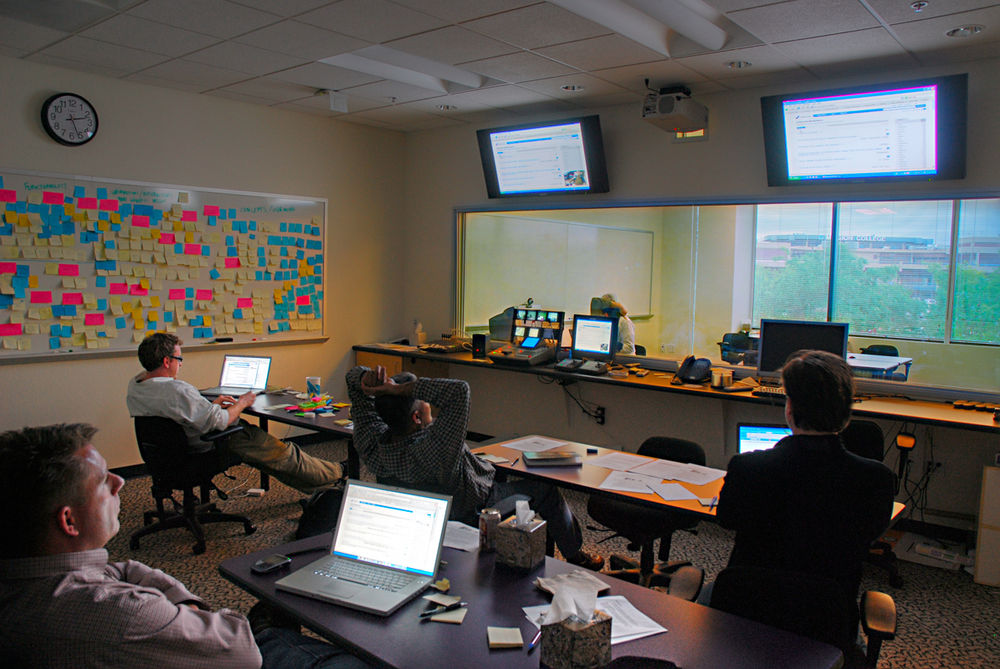
How to Visualize Your Qualitative User Research Results for Maximum Impact

Shadowing in User Research - Do You See What They See?
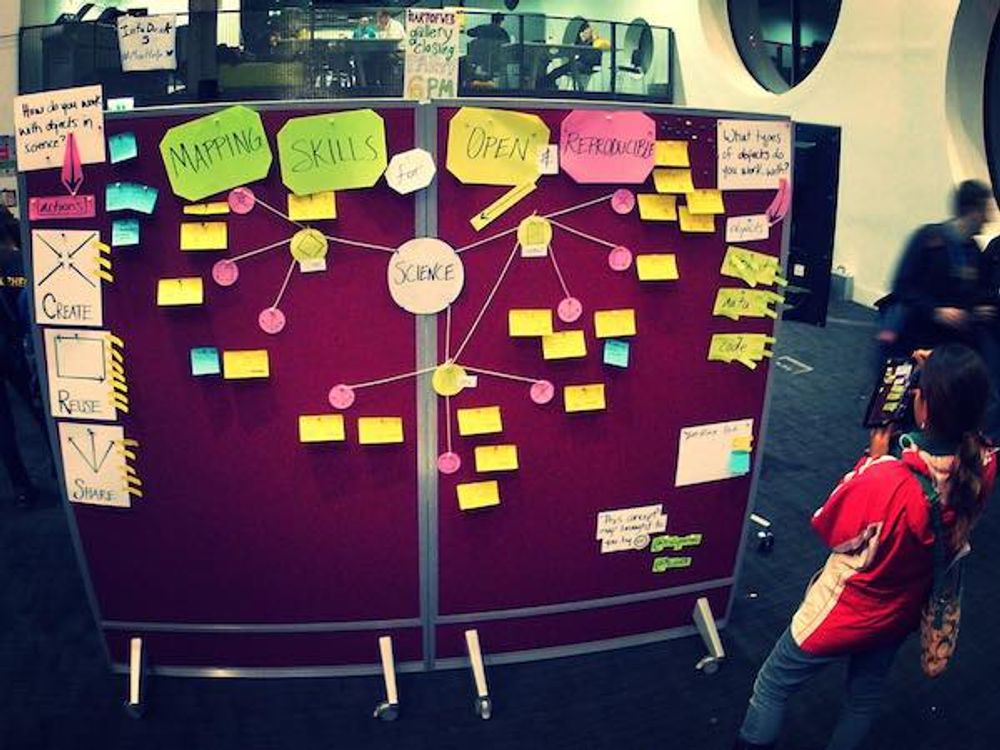
Creating Personas from User Research Results

The Basics of Recruiting Participants for User Research

Co-Cultures and Value Framing: Know your users

- 4 years ago
How to Conduct Focus Groups

Understand the User’s Perspective through Research for Mobile UX

- 11 mths ago
Learning Experience Design - The Most Valuable Lessons

Ethnography

Chapter 11: Curated List of Research techniques
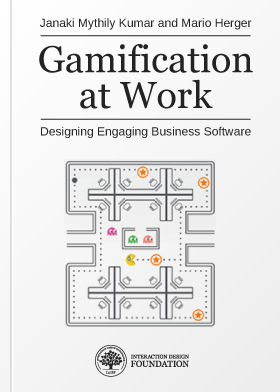
Personas for Mobile UX Design

Mobile Usability Research – The Important Differences from the Desktop

How to Prepare for a User Interview and Ask the Right Questions

5 Ways to Improve the UX of Your Applications

Open Access—Link to us!
We believe in Open Access and the democratization of knowledge . Unfortunately, world-class educational materials such as this page are normally hidden behind paywalls or in expensive textbooks.
If you want this to change , cite this page , link to us, or join us to help us democratize design knowledge !
Privacy Settings
Our digital services use necessary tracking technologies, including third-party cookies, for security, functionality, and to uphold user rights. Optional cookies offer enhanced features, and analytics.
Experience the full potential of our site that remembers your preferences and supports secure sign-in.
Governs the storage of data necessary for maintaining website security, user authentication, and fraud prevention mechanisms.
Enhanced Functionality
Saves your settings and preferences, like your location, for a more personalized experience.
Referral Program
We use cookies to enable our referral program, giving you and your friends discounts.
Error Reporting
We share user ID with Bugsnag and NewRelic to help us track errors and fix issues.
Optimize your experience by allowing us to monitor site usage. You’ll enjoy a smoother, more personalized journey without compromising your privacy.
Analytics Storage
Collects anonymous data on how you navigate and interact, helping us make informed improvements.
Differentiates real visitors from automated bots, ensuring accurate usage data and improving your website experience.
Lets us tailor your digital ads to match your interests, making them more relevant and useful to you.
Advertising Storage
Stores information for better-targeted advertising, enhancing your online ad experience.
Personalization Storage
Permits storing data to personalize content and ads across Google services based on user behavior, enhancing overall user experience.
Advertising Personalization
Allows for content and ad personalization across Google services based on user behavior. This consent enhances user experiences.
Enables personalizing ads based on user data and interactions, allowing for more relevant advertising experiences across Google services.
Receive more relevant advertisements by sharing your interests and behavior with our trusted advertising partners.
Enables better ad targeting and measurement on Meta platforms, making ads you see more relevant.
Allows for improved ad effectiveness and measurement through Meta’s Conversions API, ensuring privacy-compliant data sharing.
LinkedIn Insights
Tracks conversions, retargeting, and web analytics for LinkedIn ad campaigns, enhancing ad relevance and performance.
LinkedIn CAPI
Enhances LinkedIn advertising through server-side event tracking, offering more accurate measurement and personalization.
Google Ads Tag
Tracks ad performance and user engagement, helping deliver ads that are most useful to you.
Share Knowledge, Get Respect!
or copy link
Cite according to academic standards
Simply copy and paste the text below into your bibliographic reference list, onto your blog, or anywhere else. You can also just hyperlink to this page.
New to UX Design? We’re Giving You a Free ebook!

Download our free ebook The Basics of User Experience Design to learn about core concepts of UX design.
In 9 chapters, we’ll cover: conducting user interviews, design thinking, interaction design, mobile UX design, usability, UX research, and many more!
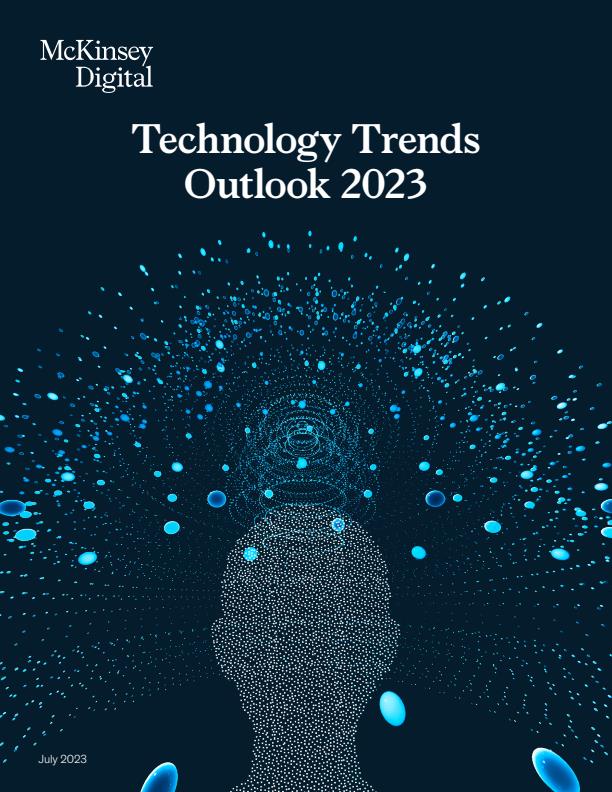
McKinsey Technology Trends Outlook 2023
After a tumultuous 2022 for technology investment and talent, the first half of 2023 has seen a resurgence of enthusiasm about technology’s potential to catalyze progress in business and society. Generative AI deserves much of the credit for ushering in this revival, but it stands as just one of many advances on the horizon that could drive sustainable, inclusive growth and solve complex global challenges.
To help executives track the latest developments, the McKinsey Technology Council has once again identified and interpreted the most significant technology trends unfolding today. While many trends are in the early stages of adoption and scale, executives can use this research to plan ahead by developing an understanding of potential use cases and pinpointing the critical skills needed as they hire or upskill talent to bring these opportunities to fruition.
Our analysis examines quantitative measures of interest, innovation, and investment to gauge the momentum of each trend. Recognizing the long-term nature and interdependence of these trends, we also delve into underlying technologies, uncertainties, and questions surrounding each trend. This year, we added an important new dimension for analysis—talent. We provide data on talent supply-and-demand dynamics for the roles of most relevance to each trend. (For more, please see the sidebar, “Research methodology.”)
New and notable
All of last year’s 14 trends remain on our list, though some experienced accelerating momentum and investment, while others saw a downshift. One new trend, generative AI, made a loud entrance and has already shown potential for transformative business impact.
Research methodology
To assess the development of each technology trend, our team collected data on five tangible measures of activity: search engine queries, news publications, patents, research publications, and investment. For each measure, we used a defined set of data sources to find occurrences of keywords associated with each of the 15 trends, screened those occurrences for valid mentions of activity, and indexed the resulting numbers of mentions on a 0–1 scoring scale that is relative to the trends studied. The innovation score combines the patents and research scores; the interest score combines the news and search scores. (While we recognize that an interest score can be inflated by deliberate efforts to stimulate news and search activity, we believe that each score fairly reflects the extent of discussion and debate about a given trend.) Investment measures the flows of funding from the capital markets into companies linked with the trend. Data sources for the scores include the following:
- Patents. Data on patent filings are sourced from Google Patents.
- Research. Data on research publications are sourced from the Lens (www.lens.org).
- News. Data on news publications are sourced from Factiva.
- Searches. Data on search engine queries are sourced from Google Trends.
- Investment. Data on private-market and public-market capital raises are sourced from PitchBook.
- Talent demand. Number of job postings is sourced from McKinsey’s proprietary Organizational Data Platform, which stores licensed, de-identified data on professional profiles and job postings. Data is drawn primarily from English-speaking countries.
In addition, we updated the selection and definition of trends from last year’s study to reflect the evolution of technology trends:
- The generative-AI trend was added since last year’s study.
- We adjusted the definitions of electrification and renewables (previously called future of clean energy) and climate technologies beyond electrification and renewables (previously called future of sustainable consumption).
- Data sources were updated. This year, we included only closed deals in PitchBook data, which revised downward the investment numbers for 2018–22. For future of space technologies investments, we used research from McKinsey’s Aerospace & Defense Practice.
This new entrant represents the next frontier of AI. Building upon existing technologies such as applied AI and industrializing machine learning, generative AI has high potential and applicability across most industries. Interest in the topic (as gauged by news and internet searches) increased threefold from 2021 to 2022. As we recently wrote, generative AI and other foundational models change the AI game by taking assistive technology to a new level, reducing application development time, and bringing powerful capabilities to nontechnical users. Generative AI is poised to add as much as $4.4 trillion in economic value from a combination of specific use cases and more diffuse uses—such as assisting with email drafts—that increase productivity. Still, while generative AI can unlock significant value, firms should not underestimate the economic significance and the growth potential that underlying AI technologies and industrializing machine learning can bring to various industries.
Investment in most tech trends tightened year over year, but the potential for future growth remains high, as further indicated by the recent rebound in tech valuations. Indeed, absolute investments remained strong in 2022, at more than $1 trillion combined, indicating great faith in the value potential of these trends. Trust architectures and digital identity grew the most out of last year’s 14 trends, increasing by nearly 50 percent as security, privacy, and resilience become increasingly critical across industries. Investment in other trends—such as applied AI, advanced connectivity, and cloud and edge computing—declined, but that is likely due, at least in part, to their maturity. More mature technologies can be more sensitive to short-term budget dynamics than more nascent technologies with longer investment time horizons, such as climate and mobility technologies. Also, as some technologies become more profitable, they can often scale further with lower marginal investment. Given that these technologies have applications in most industries, we have little doubt that mainstream adoption will continue to grow.
Organizations shouldn’t focus too heavily on the trends that are garnering the most attention. By focusing on only the most hyped trends, they may miss out on the significant value potential of other technologies and hinder the chance for purposeful capability building. Instead, companies seeking longer-term growth should focus on a portfolio-oriented investment across the tech trends most important to their business. Technologies such as cloud and edge computing and the future of bioengineering have shown steady increases in innovation and continue to have expanded use cases across industries. In fact, more than 400 edge use cases across various industries have been identified, and edge computing is projected to win double-digit growth globally over the next five years. Additionally, nascent technologies, such as quantum, continue to evolve and show significant potential for value creation. Our updated analysis for 2023 shows that the four industries likely to see the earliest economic impact from quantum computing—automotive, chemicals, financial services, and life sciences—stand to potentially gain up to $1.3 trillion in value by 2035. By carefully assessing the evolving landscape and considering a balanced approach, businesses can capitalize on both established and emerging technologies to propel innovation and achieve sustainable growth.
Tech talent dynamics
We can’t overstate the importance of talent as a key source in developing a competitive edge. A lack of talent is a top issue constraining growth. There’s a wide gap between the demand for people with the skills needed to capture value from the tech trends and available talent: our survey of 3.5 million job postings in these tech trends found that many of the skills in greatest demand have less than half as many qualified practitioners per posting as the global average. Companies should be on top of the talent market, ready to respond to notable shifts and to deliver a strong value proposition to the technologists they hope to hire and retain. For instance, recent layoffs in the tech sector may present a silver lining for other industries that have struggled to win the attention of attractive candidates and retain senior tech talent. In addition, some of these technologies will accelerate the pace of workforce transformation. In the coming decade, 20 to 30 percent of the time that workers spend on the job could be transformed by automation technologies, leading to significant shifts in the skills required to be successful. And companies should continue to look at how they can adjust roles or upskill individuals to meet their tailored job requirements. Job postings in fields related to tech trends grew at a very healthy 15 percent between 2021 and 2022, even though global job postings overall decreased by 13 percent. Applied AI and next-generation software development together posted nearly one million jobs between 2018 and 2022. Next-generation software development saw the most significant growth in number of jobs (exhibit).

Image description:
Small multiples of 15 slope charts show the number of job postings in different fields related to tech trends from 2021 to 2022. Overall growth of all fields combined was about 400,000 jobs, with applied AI having the most job postings in 2022 and experiencing a 6% increase from 2021. Next-generation software development had the second-highest number of job postings in 2022 and had 29% growth from 2021. Other categories shown, from most job postings to least in 2022, are as follows: cloud and edge computing, trust architecture and digital identity, future of mobility, electrification and renewables, climate tech beyond electrification and renewables, advanced connectivity, immersive-reality technologies, industrializing machine learning, Web3, future of bioengineering, future of space technologies, generative AI, and quantum technologies.
End of image description.
This bright outlook for practitioners in most fields highlights the challenge facing employers who are struggling to find enough talent to keep up with their demands. The shortage of qualified talent has been a persistent limiting factor in the growth of many high-tech fields, including AI, quantum technologies, space technologies, and electrification and renewables. The talent crunch is particularly pronounced for trends such as cloud computing and industrializing machine learning, which are required across most industries. It’s also a major challenge in areas that employ highly specialized professionals, such as the future of mobility and quantum computing (see interactive).
Michael Chui is a McKinsey Global Institute partner in McKinsey’s Bay Area office, where Mena Issler is an associate partner, Roger Roberts is a partner, and Lareina Yee is a senior partner.
The authors wish to thank the following McKinsey colleagues for their contributions to this research: Bharat Bahl, Soumya Banerjee, Arjita Bhan, Tanmay Bhatnagar, Jim Boehm, Andreas Breiter, Tom Brennan, Ryan Brukardt, Kevin Buehler, Zina Cole, Santiago Comella-Dorda, Brian Constantine, Daniela Cuneo, Wendy Cyffka, Chris Daehnick, Ian De Bode, Andrea Del Miglio, Jonathan DePrizio, Ivan Dyakonov, Torgyn Erland, Robin Giesbrecht, Carlo Giovine, Liz Grennan, Ferry Grijpink, Harsh Gupta, Martin Harrysson, David Harvey, Kersten Heineke, Matt Higginson, Alharith Hussin, Tore Johnston, Philipp Kampshoff, Hamza Khan, Nayur Khan, Naomi Kim, Jesse Klempner, Kelly Kochanski, Matej Macak, Stephanie Madner, Aishwarya Mohapatra, Timo Möller, Matt Mrozek, Evan Nazareth, Peter Noteboom, Anna Orthofer, Katherine Ottenbreit, Eric Parsonnet, Mark Patel, Bruce Philp, Fabian Queder, Robin Riedel, Tanya Rodchenko, Lucy Shenton, Henning Soller, Naveen Srikakulam, Shivam Srivastava, Bhargs Srivathsan, Erika Stanzl, Brooke Stokes, Malin Strandell-Jansson, Daniel Wallance, Allen Weinberg, Olivia White, Martin Wrulich, Perez Yeptho, Matija Zesko, Felix Ziegler, and Delphine Zurkiya.
They also wish to thank the external members of the McKinsey Technology Council.
This interactive was designed, developed, and edited by McKinsey Global Publishing’s Nayomi Chibana, Victor Cuevas, Richard Johnson, Stephanie Jones, Stephen Landau, LaShon Malone, Kanika Punwani, Katie Shearer, Rick Tetzeli, Sneha Vats, and Jessica Wang.
Explore a career with us
Related articles.

McKinsey Technology Trends Outlook 2022

Value creation in the metaverse

Quantum computing funding remains strong, but talent gap raises concern
- Technology & Telecommunications ›
Industry-specific and extensively researched technical data (partially from exclusive partnerships). A paid subscription is required for full access.
TIS's R&D expenditures FY 2017-2023
TIS Inc. spent 3.1 billion Japanese yen on research and development (R&D) in fiscal year 2023. The Japanese company offers a range of IT services and solutions, such as software development, cloud-related services, and hardware maintenance.
Research and development (R&D) expenses of TIS Inc. Japan from fiscal year 2017 to 2023 (in billion Japanese yen)
- Immediate access to 1m+ statistics
- Incl. source references
- Download as PNG, PDF, XLS, PPT
Additional Information
Show sources information Show publisher information Use Ask Statista Research Service
fiscal year 2017 to 2023; the company's fiscal year ends on March 31 of the stated year
consolidated figures
100 Japanese yen equal 0.64 U.S. dollars or 0.6 euros as of May 2024. Values have been rounded. Data prior to fiscal year 2022 come from previous reporting.
Other statistics on the topic
IT Services
- Fujitsu's revenue FY 2014-2022
- Cloud services (IaaS/PaaS) market size in Japan 2021-2027
- Data center market size in Japan FY 2021-2027
Telecommunications
- Sales of the ICT industry Japan FY 2011-2020
To download this statistic in XLS format you need a Statista Account
To download this statistic in PNG format you need a Statista Account
To download this statistic in PDF format you need a Statista Account
To download this statistic in PPT format you need a Statista Account
As a Premium user you get access to the detailed source references and background information about this statistic.
As a Premium user you get access to background information and details about the release of this statistic.
As soon as this statistic is updated, you will immediately be notified via e-mail.
… to incorporate the statistic into your presentation at any time.
You need at least a Starter Account to use this feature.
- Immediate access to statistics, forecasts & reports
- Usage and publication rights
- Download in various formats
You only have access to basic statistics. This statistic is not included in your account.
- Instant access to 1m statistics
- Download in XLS, PDF & PNG format
- Detailed references
Business Solutions including all features.
Statistics on " IT industry in Japan "
- Sales of the ICT industry Japan FY 2020, by business activity
- Sales of the software industry Japan FY 2011-2020
- Sales of data processing and information service industry Japan FY 2011-2020
- IT service market size in Japan 2022-2027
- Enterprise infrastructure software market size in Japan 2018-2024
- Enterprise application software market size in Japan 2018-2024
- Private IT investment market size in Japan FY 2019-2025
- Local government aimed IT solutions market size in Japan FY 2019-2026
- IT market size for social infrastructure Japan FY 2018-2027
- IT-related BPO services market size in Japan FY 2021-2027
- ERP solution package license market size in Japan 2018-2025
- Cloud storage service market size Japan FY 2017-2022
- Edge computing market size in Japan FY 2021-2027
- Share of software businesses Japan FY 2020, by sales
- Share of software businesses Japan FY 2020, by capital size
- Share of software businesses Japan FY 2020, by company size
- Share of data processing and information service businesses Japan FY 2020, by sales
- Share of data processing businesses Japan FY 2020, by capital size
- Share of data processing businesses Japan FY 2020, by company size
- NEC's revenue FY 2014-2023
- NTT Data's net sales FY 2013-2022
- Otsuka Corporation's net sales FY 2016-2023
- Nomura Research Institute's revenue FY 2013-2022
Other statistics that may interest you IT industry in Japan
- Premium Statistic Sales of the ICT industry Japan FY 2011-2020
- Premium Statistic Sales of the ICT industry Japan FY 2020, by business activity
- Premium Statistic Sales of the software industry Japan FY 2011-2020
- Premium Statistic Sales of data processing and information service industry Japan FY 2011-2020
Private and public demand
- Premium Statistic IT service market size in Japan 2022-2027
- Premium Statistic Enterprise infrastructure software market size in Japan 2018-2024
- Premium Statistic Enterprise application software market size in Japan 2018-2024
- Premium Statistic Private IT investment market size in Japan FY 2019-2025
- Premium Statistic Local government aimed IT solutions market size in Japan FY 2019-2026
- Premium Statistic IT market size for social infrastructure Japan FY 2018-2027
Software and service markets
- Premium Statistic IT-related BPO services market size in Japan FY 2021-2027
- Premium Statistic Data center market size in Japan FY 2021-2027
- Premium Statistic Cloud services (IaaS/PaaS) market size in Japan 2021-2027
- Premium Statistic ERP solution package license market size in Japan 2018-2025
- Premium Statistic Cloud storage service market size Japan FY 2017-2022
- Premium Statistic Edge computing market size in Japan FY 2021-2027
Composition of the industry
- Premium Statistic Share of software businesses Japan FY 2020, by sales
- Premium Statistic Share of software businesses Japan FY 2020, by capital size
- Premium Statistic Share of software businesses Japan FY 2020, by company size
- Premium Statistic Share of data processing and information service businesses Japan FY 2020, by sales
- Premium Statistic Share of data processing businesses Japan FY 2020, by capital size
- Premium Statistic Share of data processing businesses Japan FY 2020, by company size
Leading companies
- Premium Statistic Fujitsu's revenue FY 2014-2022
- Premium Statistic NEC's revenue FY 2014-2023
- Premium Statistic NTT Data's net sales FY 2013-2022
- Premium Statistic Otsuka Corporation's net sales FY 2016-2023
- Premium Statistic Nomura Research Institute's revenue FY 2013-2022
Further Content: You might find this interesting as well
Numbers, Facts and Trends Shaping Your World
Read our research on:
Full Topic List
Regions & Countries
- Publications
- Our Methods
- Short Reads
- Tools & Resources
Read Our Research On:
More Americans want the journalists they get news from to share their politics than any other personal trait

Most Americans say it is not important that the news they get comes from journalists who share their political views, age, gender or other traits. But people are more likely to say it is important for journalists to share their politics than any other characteristic we asked about. And certain demographic groups place more value than others on the personal traits of their journalists.
A 2023 Pew Research Center survey asked Americans how important it is for the journalists they get news from to have six personal characteristics that are similar to their own.
Pew Research Center conducted this analysis as part of a broader look at Americans’ views of the news media. The data for this analysis comes from a survey of 10,701 U.S. adults from March 13 to 19, 2023.
Everyone who completed the survey is a member of the Center’s American Trends Panel (ATP), an online survey panel that is recruited through national, random sampling of residential addresses. This way nearly all U.S. adults have a chance of selection. The survey is weighted to be representative of the U.S. adult population by gender, race, ethnicity, partisan affiliation, education and other categories. Read more about the ATP’s methodology .
Here are the questions used for this analysis , along with responses, and the survey methodology .
Pew Research Center is a subsidiary of The Pew Charitable Trusts, its primary funder. This is the latest analysis in Pew Research Center’s ongoing investigation of the state of news, information and journalism in the digital age, a research program funded by The Pew Charitable Trusts, with generous support from the John S. and James L. Knight Foundation.
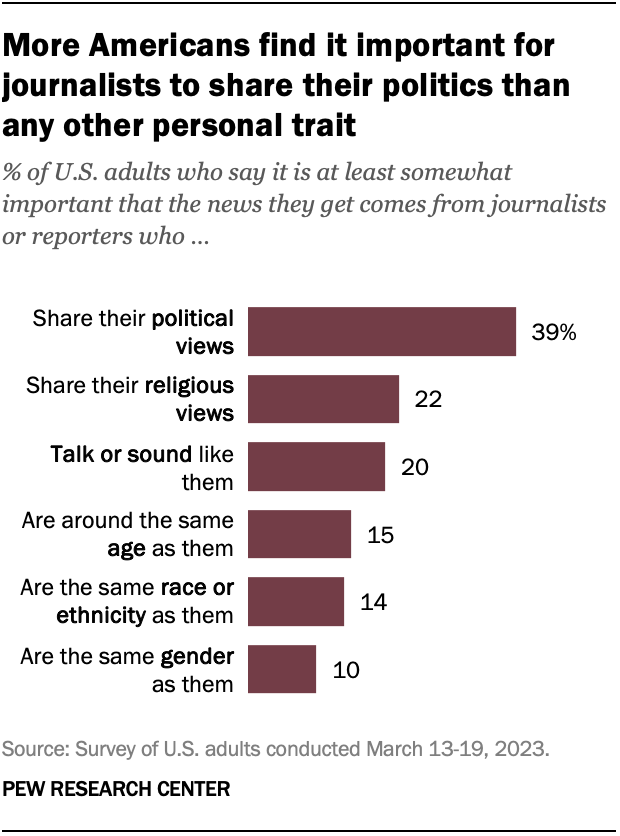
About four-in-ten Americans say it is at least somewhat important that they get news from journalists who share their political views (39%). That is nearly double the share who say the same about getting news from journalists who share their religious views (22%) or who talk or sound like them (20%).
Smaller shares say they want to get news from journalists who are similar to them in age (15%), share their race or ethnicity (14%), or share their gender (10%).
On several of these questions, opinions vary based on respondents’ political views, age and other personal traits.
Political views
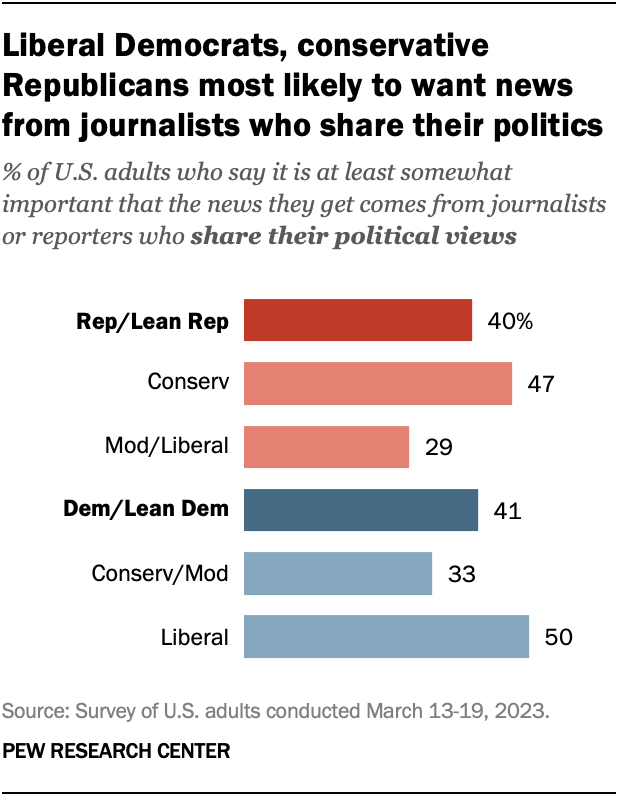
Similar shares of Republicans and Democrats say it is at least somewhat important for the news they get to come from journalists who share their political views. Four-in-ten Republicans and GOP-leaning independents say this, compared with 41% of Democrats and Democratic leaners.
When combining party and ideology, people who place themselves at either end of the political spectrum are more likely than those toward the center to say journalists’ politics are important.
- Roughly half each of conservative Republicans (47%) and liberal Democrats (50%) say it is important that the news they get comes from journalists who share their politics.
- Smaller shares of liberal and moderate Republicans (29%) and conservative and moderate Democrats (33%) hold this view.
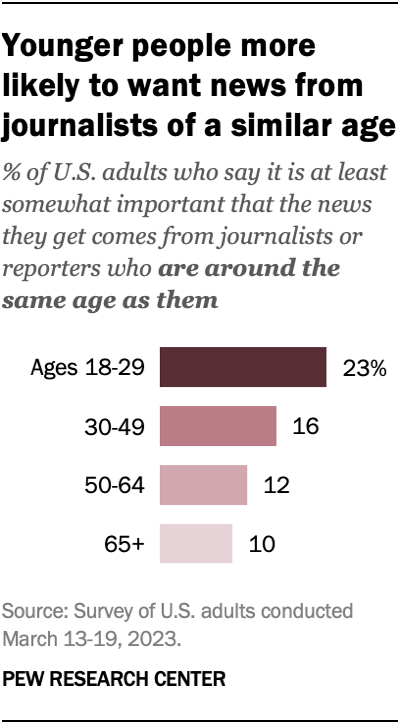
Younger adults are more likely than older Americans to say they want news from journalists who are around the same age as them. Among U.S. adults ages 18 to 29, 23% say this is at least somewhat important, compared with one-in-ten of those ages 65 and older.
Younger adults are also more likely than older adults to say it’s important that the journalists they get news from are the same gender as them; still, large majorities say this is not important. Some 16% of those ages 18 to 29 say it is at least somewhat important for journalists to share their gender, versus 6% of those 65 and older.
Race or ethnicity
Black Americans are more likely than other racial or ethnic groups to say it is important they get news from journalists who share several of their characteristics – particularly their race or ethnicity.
About four-in-ten Black Americans (41%) say it is at least somewhat important that the news they get comes from journalists who share their race or ethnicity. A quarter of Hispanic Americans, 20% of Asian Americans and just 5% of White Americans say the same.
For more information on how Black Americans answered these questions, read our report on Black Americans and news .
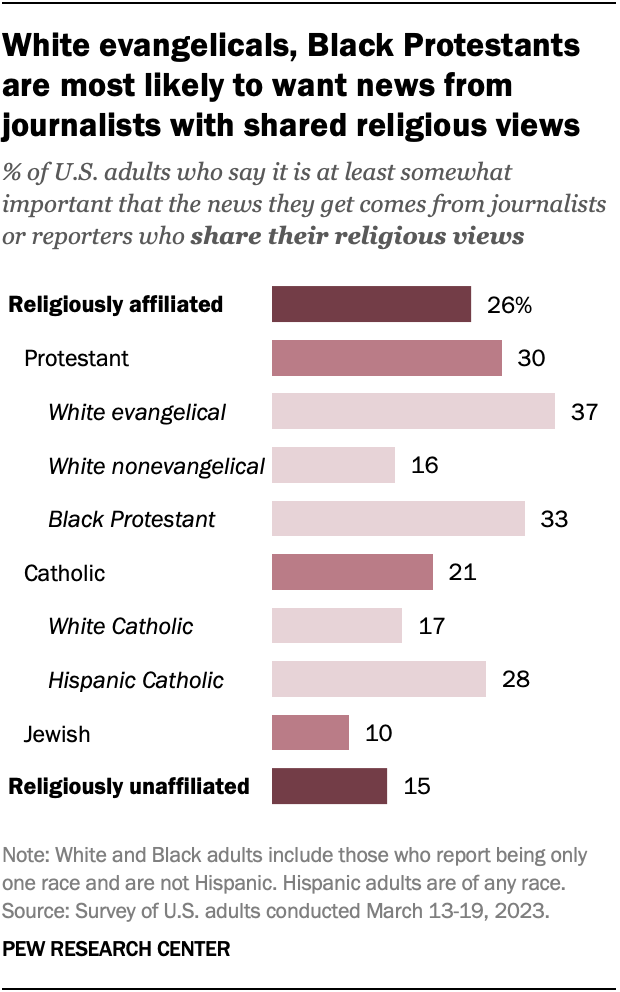
Overall, Americans who identify with a religion are more likely than those who are religiously unaffiliated to find it at least somewhat important to get news from journalists who share their religious views (26% vs. 15%).
Among Christians, Protestants are more likely than Catholics to say it is important for journalists to share their religious views (30% vs. 21%). But there are also differences among Protestants and among Catholics:
- White evangelical Protestants (37%) and Black Protestants (33%) are about twice as likely as White nonevangelical Protestants (16%) to say this.
- About three-in-ten Hispanic Catholics say this (28%), compared with 17% of White Catholics.
Among Jewish Americans, just 10% say it’s at least somewhat important to get news from journalists who share their religious views.
Note: Here are the questions used for this analysis , along with responses, and the survey methodology .
- Journalists
- News Coverage

Emily Tomasik is a research assistant focusing on news and information research at Pew Research Center .
Americans’ Changing Relationship With Local News
Most u.s. journalists are concerned about press freedoms, about one-in-six u.s. journalists at news outlets are part of a union; many more would join one if they could, u.s. journalists differ from the public in their views of ‘bothsidesism’ in journalism, twitter is the go-to social media site for u.s. journalists, but not for the public, most popular.
1615 L St. NW, Suite 800 Washington, DC 20036 USA (+1) 202-419-4300 | Main (+1) 202-857-8562 | Fax (+1) 202-419-4372 | Media Inquiries
Research Topics
- Email Newsletters
ABOUT PEW RESEARCH CENTER Pew Research Center is a nonpartisan fact tank that informs the public about the issues, attitudes and trends shaping the world. It conducts public opinion polling, demographic research, media content analysis and other empirical social science research. Pew Research Center does not take policy positions. It is a subsidiary of The Pew Charitable Trusts .
Copyright 2024 Pew Research Center
Create an account
Create a free IEA account to download our reports or subcribe to a paid service.
Market review
- Executive summary
- Outlook for key minerals
Cite report
IEA (2024), Global Critical Minerals Outlook 2024 , IEA, Paris https://www.iea.org/reports/global-critical-minerals-outlook-2024, Licence: CC BY 4.0
Share this report
- Share on Twitter Twitter
- Share on Facebook Facebook
- Share on LinkedIn LinkedIn
- Share on Email Email
- Share on Print Print
Report options
Global clean energy deployment and ev sales climbed to new heights in 2023, spurring strong growth in demand for critical minerals during a turbulent year for mineral markets.
Clean energy technologies had another record year, with annual additions of solar PV growing 85% and wind turbines growing 60%. Electric car sales neared 14 million in 2023, a 35% year-on-year increase, and more than six times higher than five years earlier in 2018. Almost half of global battery storage capacity, over 40 GW, was added in 2023 alone, a record year that saw additions doubling from 2022. Propelled by this expansion, the rate of demand growth for critical minerals remained robust in 2023, with lithium demand rising by 30% and demand for nickel, cobalt and graphite expanding by 8-10%. Clean energy applications were one of the primary contributors to this demand growth. Across all key minerals, the share of clean energy technologies has risen consistently.
However, the critical minerals market had a turbulent year in 2023 and the main story of the year was falling prices. Battery minerals saw particularly large declines with lithium spot prices plummeting by 75% and other key materials such as nickel, cobalt, manganese, and graphite seeing declines of 30-45%. In contrast, prices for copper stayed relatively resilient. Overall, a combination of demand and supply-side trends, alongside a correction of overly steep price rises in 2021-2022 contributed to the lower price environment, which is likely to continue in 2024. As a result, despite demand growth, the market size for energy transition minerals contracted by 10% to USD 325 billion in 2023.
Production growth has been accompanied by rising levels of geographical concentration, with the trends particularly pronounced for nickel and cobalt
In the case of refined materials, the share of the top three producing nations have all increased since 2020, except for lithium. This trend is most pronounced for nickel and cobalt, where the rise of Indonesia has significantly boosted the level of supply concentration. Between 2020 and 2023, Indonesia's share of mined nickel production increased from 34% to 52% and its share of refined nickel increased from 23% to 37%.
For mining, however, assessing production by ownership (based on the leading owner company’s headquarter location) shows a very different picture compared with the geographical mine location. Companies in the United States and Europe play a much greater role in the supply of all critical minerals than what the geographical location of mines may suggest. Much of this is from some of the largest multi-national mining majors such as Glencore and Rio Tinto. Both nickel and cobalt also show stark differences between the geographical location of mines compared with the ownership. Although Indonesia is the leading location of nickel mining, Indonesian companies lead hold less than 10% of production. Chinese companies are the major nickel mine owners, accounting for around 40% of production. European companies also have a sizeable share with over 20% of supply, predominantly due to operations in Indonesia owned by Eramet. For cobalt, the majority of mines are located in the Democratic Republic of the Congo (DRC), whereas European companies such as Glencore and Chinese companies such as CMOC own a third each of the supply. Notably, DRC-owned companies account for less than 5% of production.
Reduced material prices and increased manufacturing capacity underpinned major cost reductions for clean energy technologies, with solar PV and batteries reaching record lows
While the low-price environment in the minerals’ market may foster additional deployment of clean energy technologies in the medium term, it currently presents challenges for producers’ financial performance. Industry revenues declined by 10% in 2023 while operating profits plummeted by 34%. Free cash flow also decreased by over 40%, constraining the industry's ability to allocate significant capital for future growth.
Capital expenditure on nonferrous metal production by 25 major mining companies, 2011-2023
Investment in critical mineral mining grew by 10% in 2023, a smaller increase than seen in 2022, as price declines placed pressure on producers’ financial capacity.
We have assessed the combined investment levels of 25 major mining companies with substantial involvement in developing minerals essential for the energy transition. These companies encompass diversified mining majors and specialised developers focused on specific energy transition minerals such as copper, nickel, cobalt, and lithium. The assessment suggests that investment in critical minerals mining grew by 10% in 2023 (6% when adjusted for inflation), a smaller increase compared with the 30% growth in 2022. While investment spending by diversified majors increased by 15%, investment by lithium specialists saw a sharp rise by 60%, despite headwinds from weak prices.
Exploration spending grew by 15% in 2023, with Canada and Australia registering the largest increases, followed closely by Africa. Spending for lithium exhibited an impressive 80% increase despite challenging market conditions, followed by platinum and nickel.
Notable critical mineral deals in 2023 included USD 50 million series A investment by Canada-based Summit Nanotech to scale its more sustainable lithium extraction technology. In the United States, Kobold Metals raised USD 195 million in growth equity to expand cobalt extraction, Energy Exploration Technologies raised USD 50 million for direct lithium extraction from GM Ventures, and Atlas Materials raised USD 27 million in seed money to develop nickel extraction technologies.
Producing countries intensify efforts to secure economic benefits; consumer nations enact significant laws and regulations to ensure an adequate and responsible supply
While some producing countries already have high-level critical minerals strategies, such as Australia and Canada, more critical minerals strategies are now under development, particularly by new market entrants. The African Minerals Development Centre (ADMC) is developing an African Green Minerals Strategy which will aim to guide African countries as they consider how to exploit their raw materials. Individual countries are also in the process of developing strategies, such as Zambia, which is intending to release a critical minerals strategy in 2024. Some mineral-producing jurisdictions have created public strategic minerals investment funds. In February 2024, Brazil announced a USD 200 million fund to support both exploration and improvements in ESG practices. In October 2023, Australia expanded its Critical Minerals Facility with a USD 1.3 billion investment, financing extraction and processing projects. Canada’s CAD 1.5 billion (Canadian dollars 1 ) Strategic Innovation Fund, as part of the CAD 2.8 billion Critical Minerals Strategy, aims to prioritise innovative critical minerals manufacturing, processing and recycling projects.
Selected environmental, social and governance indicators for critical mineral developments by areas of attention, 2019-2022
Selected environmental, social and governance indicators for critical mineral developments by positive trends, 2019-2022.
In Latin America, both Mexico and Chile enacted policies to develop their domestic lithium mining industries. Mexico followed its 2022 Mining Reform with legislative amendments in 2023 that streamlined the mining permitting process and strengthened environmental and social protections. Chile also followed its 2023 National Lithium Strategy with an update to its Mining Royalty Law in 2023. The law established a mining royalty for the exploitation of copper and lithium to distribute economic benefits across the country, along with a legal body to administer it.
The Inflation Reduction Act of the United States provides funding to various government agencies to hire new personnel and develop tools and guidance to strengthen and accelerate environmental reviews. The proposed Critical Raw Materials Act (CRMA) of the European Union would allow certain projects to be designated as “strategic” that would have a streamlined permitting process. The act lays out criteria for a project to be designated as “strategic,” including whether the project would be implemented sustainably and responsibly. Besides permitting processes, the CRMA would also create a monitoring mechanism to mitigate the risk of supply chain bottlenecks.
Consumer countries have developed laws and regulations targeting sufficient supplies of responsible critical minerals. This has been particularly true in countries with large downstream manufacturing industries, which rely on a supply of these minerals.
Japan announced a policy on initiatives for ensuring stable supply of critical minerals in 2023, which aims to secure supplies for its battery manufacturing goals and provides subsidies for exploration, feasibility studies, mine development, smelting and research and development to develop supplies. Korea announced a list of 33 critical minerals and 10 strategic critical minerals, of which the latter will be prioritised to stabilise the supply chain of high-tech industries such as semi-conductors and secondary batteries.
Some countries also make financing support available for overseas projects through direct equity investments or sovereign wealth funds, such as in Japan, Saudi Arabia and China. The United Kingdom also pledged USD 1 million to identify bankable projects in processing and midstream value addition in 14 African countries.
Strategic plans have incorporated measures aimed at boosting rates of battery recycling, and 2023 saw a notable uptick in policies aimed at increasing the recycling of clean energy technologies to secure critical minerals from both consumer and producer countries. The European Union’s Critical Raw Materials Act will require member states to identify, adopt and implement measures to improve the collection and recycling of critical mineral-rich waste, as well as investigate the potential for recovery of critical raw materials from extractive waste in active and historic mining sites. Specific measures to increase recycling have come in the form of investment into research and development and waste collection, such as the United States’ USD 192 million of funding for increasing recycling rates and research and development into battery recycling technologies from consumer products.
Current company reporting does not allow for an industry-wide assessment of progress towards sustainable and responsible supply, but ESG performance is slowly becoming clearer
Progress has been observed for several ESG indicators. From 2019 to 2022, reported injury rates decreased by nearly 30%, investments in communities surged from USD 0.3 billion to USD 1 billion, and the average share of female workers went from just over 15% to 20%.
On the other hand, there are many areas where progress has been limited and some even show negative trends. The amount of waste generated per unit of mineral produced increased by over 20% from 2019 to 2022, potentially due to the development of lower-grade resources. Reported water consumption increased by around 25% during this period even in the face of high supply risks related to droughts for copper and other minerals. Similarly, indicators related to land rehabilitation, effluent discharge and GHG emissions did not exhibit visible improvements despite growing ESG commitments.
Voluntary sustainability standards can help actors improve performance and earn ESG credentials. These include the ICMM‘s Mining Principles and performance expectations, the Initiative for Responsible Mining Assurance‘s Standard for Responsible Mining, Canada’s Towards Sustainable Mining, the Responsible Minerals Initiative and the Copper Mark’s Risk Readiness Assessment Criteria Guide. Material traceability services are also on the rise. This involves working with suppliers to track sources and related impacts up to the point of incorporation into an end product. It can allow an assessment of risks and ESG performance along the supply chain, contributing to increased mineral security.
As of 16 May 2024, USD 1= CAD 1.36.
Reference 1
Subscription successful.
Thank you for subscribing. You can unsubscribe at any time by clicking the link at the bottom of any IEA newsletter.
From IV treatments to cold plunges here are the biggest anti-aging trends sweeping the nation
- The quest for longevity has gone mainstream as more people seek ways to reverse the aging process.
- People are resorting to IV treatments, saunas, and luxury longevity clinics to extend their lifespan.
- Here are some of the top longevity trends right now, according to industry experts.

The quest to live longer has long been a focus of the world's wealthiest entrepreneurs. But now it's gone mainstream.
People across the country are taking prescription pills, getting specialized injections, and implementing a range of behavioral practices in the hopes of reversing aging . Research shows that these trends can slow down cellular aging , increase cognitive function, and even delay the onset of chronic diseases.
Still, it's important to view these practices simply as tools, similar to "hammers or screwdrivers," said longevity specialist Dr. Anant Vinjamoori. Their value ultimately depends on the context in which they're implemented, and it's worth tailoring your approach to suit your individual needs, he said.
Whether you prefer the luxe atmosphere of a longevity clinic or the rush of a cold plunge, take a look at some of the most popular longevity trends sweeping the country.
There is a growing body of scientific evidence that supports cold exposure as an anti-aging hack.
Whether you plunge into a pool of ice-cold water or try cryotherapy — which involves spending a few minutes in a below-freezing chamber — cold exposure has benefits that may help slow down the clock. Anant Vinjamoori, chief medical officer of longevity-focused healthcare company Modern Age , told Insider that cold exposure produces effective results in the short and long term.
A plunge into an ice-cold bath results in "a surge in the production of neurotransmitters such as epinephrine and dopamine," which have immediate rejuvenating and energizing effects, he said.
"Over the medium to long term, there is some evidence that cold exposure may reduce systemic inflammation, which is known to be a driver of many chronic diseases," Vinjamoori added.
High-end longevity clinics that offer everything from genetic testing to cocktails of supplements are growing in popularity — especially among high-income groups.
Many of these longevity centers offer packages or retreats that can be pretty pricey — sometimes upwards of tens of thousands of dollars a week — but longevity experts contend that they are some of the best places to get practical longevity guidance. "The truth is that most people are probably wasting time and money on products that will never materially help them," Matt Fellowes, an advisory council member at the Stanford Center on Longevity and cofounder of health insights platform BellSant, told Business Insider by email. "One exception are some of the clinics that cater to high-income adults, which are actually science-based and, most importantly, create highly personalized assessments and guidance for people – meaning, they only focus on what their specific bodies need."
At Clinique La Prairie — a more than 90-year-old longevity center in Switzerland — the seven-day, six-night "premium revitalization" package includes longevity consultations, sleep quality assessments, DNA tests, personalized nutrition guidance, and personal training sessions, alongside luxury accommodation and limousine service for about $53,000. The program "stimulates cell regeneration, fights the signs and causes of aging, and reinforces the immune system through a four-pillared approach of medicine, nutrition, wellbeing, and movement," a spokesperson for Clinique La Prairie previously told BI. There are less expensive options, however.
Time-restricted eating has been shown to have a host of health benefits.
Research suggests that time-restricted eating patterns can result in health benefits for those with diabetes and obesity or even enhance the body's defenses against oxidative stress .
"For me, the primary benefit of time-restricted eating is regulating circadian rhythms. Sleep quality almost always improves by limiting the consumption of calories in the evening hours," said Modern Age's Vinjamoori.
Try skipping the meat and adopting a plant-based diet, instead.
Those who cut out animal protein— and stick to a relatively plant-based diet— are likely to live longer and healthier lives, according to studies.
David Sinclair, a Harvard Medical School professor and longevity researcher, said that high animal protein diets really only help people feel better in the short term.
"I'm convinced, and the data shows it from population studies, that a carnivorous diet is not a longevity-producing diet in the long run," he said on an episode of "The Knowledge Project Podcast."
In many of the world's Blue Zones— areas where people tend to reach the age of 100 — people are likely to have a relatively plant-focused diet.
Red light therapy uses LED lights or lasers to expose the body to red light— the longest wavelength of light on the visible spectrum.
There is research to suggest that exposing oneself to red light for five to 20 minutes may increase production of adenosine triphosphate, which is a compound that provides and stores energy for the cells. "While more research is needed to understand the full benefits and mechanisms of red light therapy, there is evidence to suggest it may be beneficial in improving certain skin conditions including acne, aging, hair loss, wound care, and sun damage," dermatologist Laura Buford previously told Insider.
Supplements like NMN can help boost critical enzymes in the body to improve cellular function.
NMN, or Nicotinamide Mononucleotide, is a supplement that can help boost levels of a critical coenzyme in the body called NAD+.
NAD+ is vital in facilitating metabolic processes and maintaining healthy cellular function.
Harvard Medical School professor Sinclair — who has studied the relationship between NAD+ and aging — said in an interview with the YouTube channel Reverse Aging Revolution that the human body uses NAD+ as "a measure of adversity." As humans get older, NAD+ levels decrease, which means the body's defense enzymes and repair enzymes take a hit, and humans "succumb to aging," Sinclair said .
Since NAD+ is a large molecule, it's difficult to take it directly. Sinclair recommends taking its building blocks like B3, Nicotinamide riboside (NR), or NMN.
"What we've discovered in people, in clinical trials, is that the closer you get to the NAD itself, the better the boost in NAD that you get," Sinclair said , which is why he recommends NMN.
Or try Ashwagandha, an herb that's long been used for anti-aging in Ayurveda, an ancient system of holistic medicine originating in India.
The herb, often classified as an adaptogen, has a host of health benefits that range from easing anxiety and stress to soothing arthritis to boosting cognitive function. Modern Age's Vinjamoori said that ashwagandha has been shown in research studies to reduce cortisol, a hormone associated with stress, and improve sleep in people with insomnia.
Recent research has also shown that ashwagandha could be a promising agent in anti-aging treatments . A study published in the Journal of Clinical Medicine in 2020 found that ashwagandha may help maintain the length of the key proteins at end of chromosomes known as telomeres. Telomeres are often shortened in the process of DNA replication which has been pointed to as the main factor that "speeds up cell ageing and promotes degeneration processes" the study noted .
People that are serious about aging are also turning to prescription pills like Metformin.
Metformin, a pill prescribed for diabetes, is increasingly being used by biohackers as a way to improve how humans age and slow the onset of diseases like cancer, cognitive decline, and vision loss. The drug helps regulate blood sugar and decrease appetite, essentially giving the metabolism a boost and stimulating a cellular clean-up process known as autophagy, Insider reported .
In his book Lifespan , Harvard professor Sinclair said he takes a gram of metformin every morning along with his yogurt in the hope that it will regulate his metabolism and help his organs remain younger and healthier, Insider reported .
OpenAI CEO Sam Altman also said his personal antiaging regimen includes metformin.
And Rapamycin, an immunosuppressive drug used to help treat some cancers.
It's also used in kidney transplants to help an organ recipient's body accept new kidneys, Insider reported .
The pill can slow down cellular growth and reproduction which means it might be a way to "turn down troublesome age-related inflammation," which can contribute to age-related diseases like cancer and Alzheimer's, Business Insider reported .
Business Insider also previously reported that researchers have already seen rapamycin slow aging in flies, crustaceans, yeast, and mice . In humans, studies have shown that it may help improve immune function , especially in older adults.
Despite its potential to be a "fountain of youth," no one has really nailed down the right way to regulate the drug for aging.
Matt Kaeberlein, a longevity researcher studying rapamycin's effects on humans, previously told Insider that "the doses that people are taking off-label are all over the place," adding that, "it's the wild west."
Treatments like hormone therapy, in the form of pills or injections, have also surged in popularity.
The body's balance of hormones can shift with age and spur a variety of age-related conditions like weight gain, mood swings, fatigue, and lower sex drive, two longevity-focused doctors told Insider. As a result, they've seen an increasing patient interest in hormone therapy.
Modern Age's Vinjamoori told Business Insider that testosterone replacement has gained popularity among men and women as it has become clear that optimal testosterone levels can impact mood, libido, and even metabolism.
"The importance of testosterone for women, in particular, is underappreciated — testosterone is actually the most abundant hormone in a woman's body and is the first hormone to decline with age," Vinjamoori told Business Insider.
It's not just testosterone, but also sex hormones like estrogen and progesterone that are being sought out by patients. Vinjamoori said the options for hormone therapy range from pills to creams to patches to pellets.
Peptides are another buzzy anti-aging treatment these days.
Peptides , a broad class of anti-aging and performance-enhancing treatments, have taken off in recent years among bodybuilders, athletes, and biohackers.
They're essentially short chains of amino acids that neuroscientist Andrew Huberman has described as a "new kind of wedge in between supplements and prescription pills." Some of the most popular peptide treatments are ones that release human growth hormone and can improve fat loss and muscle repair.
"Indeed, biohackers are very excited about it because you can practically make your body do certain things," Christian Angermayer , a major investor in the longevity sector , previously told Insider.
Intravenous treatments have surged in popularity for their immediate and long-term benefits.
Intravenous treatments have long been used in hospitals to administer drugs to patients. In recent years, they've become a fixture at spas, longevity clinics, and even luxury residential buildings as a way for clients to hydrate or get a boost of minerals or supplements.
At Six Senses, a luxury resort in Ibiza, intravenous infusions are among the most popular treatments. "The direct delivery of certain nutrients via the bloodstream serves to have an instant impact on vitality whilst forming part of a broader approach to living well for longer," Dr. Tamsin Lewis, RoseBar's medical advisor, previously Business Insider .
Saunas could be a way to improve depression.
A happy and healthy mind is essential for a long life. And a new study finds that spending time in a sauna can help those battling depression.
The study involved a clinical trial of 12 adults with major depressive disorder. Over a period of eight weeks, researchers treated them with a combination of cognitive behavioral therapy and sessions in a sauna heated to about 101.3 degrees Fahrenheit for up to 140 minutes. After the trial, 11 out of the 12 participants no longer met the criteria for major depressive disorder.
Individuals with depression often have a higher-than-average body temperature. When someone's symptoms improve, their body temperature normalizes, too. The study analyzed the question: If you drive up body temperatures, can you get the body's cooling systems to work faster and mitigate the symptoms of depression?
It's a little early to make definitive claims, but the study's lead researcher, Ashley Mason, eventually wants to gather enough clinical evidence for insurance companies to cover saunas as a depression treatment.
- Main content

IMAGES
COMMENTS
Most US-based UXRs earn between $100 - $200k.; Over 50% of research practices are now decentralized.; A single ReOps Specialist supports the research efforts of 21 people on average.; Most people (87%) conduct a majority of their research remotely, regardless of their remote work status.; Fully remote work among researchers is on the decline—down from 89% in 2021 to just 51% in 2023.
If you'd like a TL;DR version of the key research trends for 2023, check out our YouTube video below for a quick runthrough of the need-to-know facts. 1. Continuous research is becoming a well-established practice. With the rise of product-led growth (PLG), more and more organizations understand the value of UX research and the importance of ...
The world of voice assistants. Google and Amazon have reportedly scaled back their voice assistant teams, resulting in layoffs and talk of "missed opportunities.". Even so, voice assistant usage is set to surge by 320% in 2023. UX teams must move beyond screen-based research to include gesture-based tests for voice interfaces.
A candid look at the 5th annual State of User Research report from start to finish. Now in its 5th year, our annual State of User Research Report unpacks the findings from a global survey of UX researchers, ReOps specialists, designers, product managers, and other people who do research. Delve deeper with the creators of the report in this enriching 1-hour on-demand webinar.
Founder of User Research Academy, Nikki Anderson-Stanier, recently posted on LinkedIn, asking what people anticipate to be the biggest UX research trends in 2023. Continuous discovery and user research maturity/democratization rose to the top, both receiving nearly 1 in 3 votes, while AI and unmoderated remote research came in third and fourth ...
of respondents agree that recommendations from research findings inspire new product opportunities (agreement score = 3.4/5) With data from 600+ product professionals, this report explores how product teams use continuous discovery and research to inform decision-making. Discover the research trends that will shape the industry in 2023 and beyond.
Keep up with the latest in UX research. Our monthly newsletter offers useful UX insights and tips, relevant research, and news from our team. As we look to 2023, check out the trends and patterns we're seeing across clients, from accessibility and inclusion to upskilling practices to employee experience.
It will involve more user research, testing, and empathy in the design process. Another trend we're likely to see in 2023 is the use of Artificial Intelligence (AI) and Machine Learning (ML) in UX ...
In short, investing in UX Research is vital, but investments must quickly deliver clear benefits and ROI, or they will be axed. {{cta-case}} 4. Wider Adoption of AI-powered UX Research Tools . One of the biggest user research trends for 2023 is the increased adoption of AI-powered research tools. As machine learning algorithms continue ...
Stay ahead of the curve with our guide to technology and industry trends in UX research. Discover tips and strategies for keeping up and staying relevant. ... User research is becoming an essential component of every level of product development, but this is particularly true for design choices. ... The first half of 2023 has shown us that UX ...
Staying on top of user research trends is critical to keep up with competitors, gather actionable user insights, and guarantee your product remains relevant,...
Short summary: The article explores the top three UX research trends in 2023 that are crucial for UX designers and product managers to understand. These trends include the adoption of a continuous research mindset, the democratization of research across various departments, and the challenges faced in conducting frequent research.
The latest research reveals that these behaviours are evolving in a number of unexpected ways, too. Fortunately however, our huge new Digital 2023 Global Overview Report - produced in partnership with Meltwater and We Are Social - has all the data and insights you need to make sense of the latest trends. Top stories in Digital 2023
Discover the latest stats and trends shaping user research in 2023 and beyond. Gain insights for effective decision-making and strategy development. As user demands and expectations evolve, conducting UX research becomes increasingly essential, particularly during a recession. In Q2 of 2023, it is imperative for leadership to recognize the ...
User research is the methodic study of target users—including their needs and pain points—so designers have the sharpest possible insights to make the best designs. User researchers use various methods to expose problems and design opportunities and find crucial information to use in their design process. Discover why user research is a ...
bootcamp.uxdesign.cc. Trend #3. Continuous research will allow you to make good and effective decisions. Product development teams use research results to increase confidence in their decisions. By the way, 74% of respondents confirmed that research directly impacts decision-making in their teams.
The 2023 Trend Report was produced alongside a sweeping study of Gen Z users across Instagram. Created in partnership with WGSN* during October 2022, Instagram measured the topics, issues, and trends that matter most to teens across the platform. Reporter Darian Symoné Harvin ( @darian) also sat down with a handful of creators to talk about ...
Our updated analysis for 2023 shows that the four industries likely to see the earliest economic impact from quantum computing—automotive, chemicals, financial services, and life sciences—stand to potentially gain up to $1.3 trillion in value by 2035. By carefully assessing the evolving landscape and considering a balanced approach ...
Home / UX / 17 UX/UI Trends for 2024. 2023 has been a roller coaster ride. So many things happened that year and happened fast. With the rise of virtual and remote working culture, UX/UI trends have seen a drastic change throughout the year. As a UX/UI practitioner, it is essential to stay informed about these forever-changing trends, and ...
The 2023 State of User Research Report found that most people (87%) conduct a majority of their research remotely, regardless of their remote work status. As any experienced remote worker knows, video conferencing software is an essential component of your remote work toolstack.
A new Pew Research Center analysis shows just how fleeting online content actually is: A quarter of all webpages that existed at one point between 2013 and 2023 are no longer accessible, as of October 2023. In most cases, this is because an individual page was deleted or removed on an otherwise functional website.
2023 PEW RESEARCH CENTER'S AMERICAN TRENDS PANEL WAVE 139 NOVEMBER-DECEMBER 2023 FINAL TOPLINE NOVEMBER 27-DECEMBER 3, 2023 ... PEW RESEARCH CENTER www.pewresearch.org ASK ALL: ... [SHOW RESPONSE OPTIONS IN SAME ORDER AS COLGJOB, WITH 6 ALWAYS LAST] Nov 27-Dec 3, 2023 15 Extremely useful 19 Very useful 29 Somewhat useful 17 Not too useful
Faster population growth in 2023 runs contrary to the widespread slowdowns that have marred most states and the country for decades. Long-term trends are better understood through 15-year compound annual growth rates, which measure the constant pace that population would have had to change each year starting in 2008 to reach its 2023 total.
TIS's R&D expenditures FY 2017-2023. Published by Statista Research Department , May 23, 2024. TIS Inc. spent 3.1 billion Japanese yen on research and development (R&D) in fiscal year 2023. The ...
Pew Research Center conducted this analysis as part of a broader look at Americans' views of the news media. The data for this analysis comes from a survey of 10,701 U.S. adults from March 13 to 19, 2023. ... 2023. Everyone who completed the survey is a member of the Center's American Trends Panel (ATP), an online survey panel that is ...
Global clean energy deployment and EV sales climbed to new heights in 2023, spurring strong growth in demand for critical minerals during a turbulent year for mineral markets. Clean energy technologies had another record year, with annual additions of solar PV growing 85% and wind turbines growing 60%. Electric car sales neared 14 million in ...
Dietary Supplements Market Size & Trends . The global dietary supplements market size was valued at USD 177.50 billion in 2023 and is projected to grow at a CAGR of 9.1% from 2024 to 2030. Rising prevalence of chronic disorders, including obesity, diabetes, heart disease, and cancer, and the busy lifestyles and resultant changes in dietary patterns of consumers are among the key factors ...
Research shows that these trends can slow down cellular aging, increase cognitive function, and even delay the onset of chronic diseases. Still, it's important to view these practices simply as ...